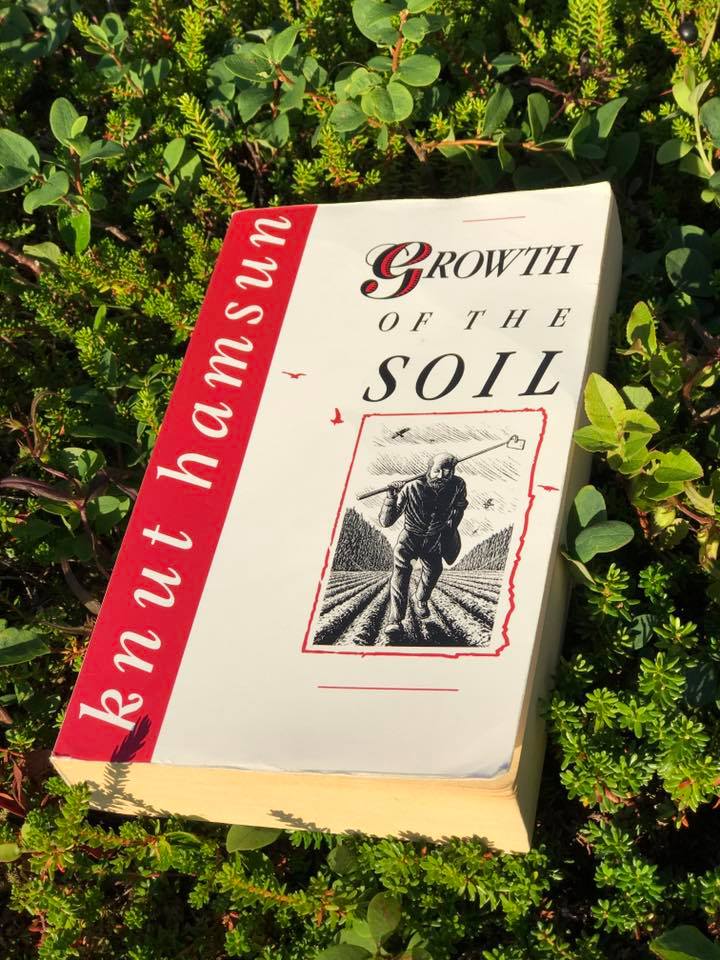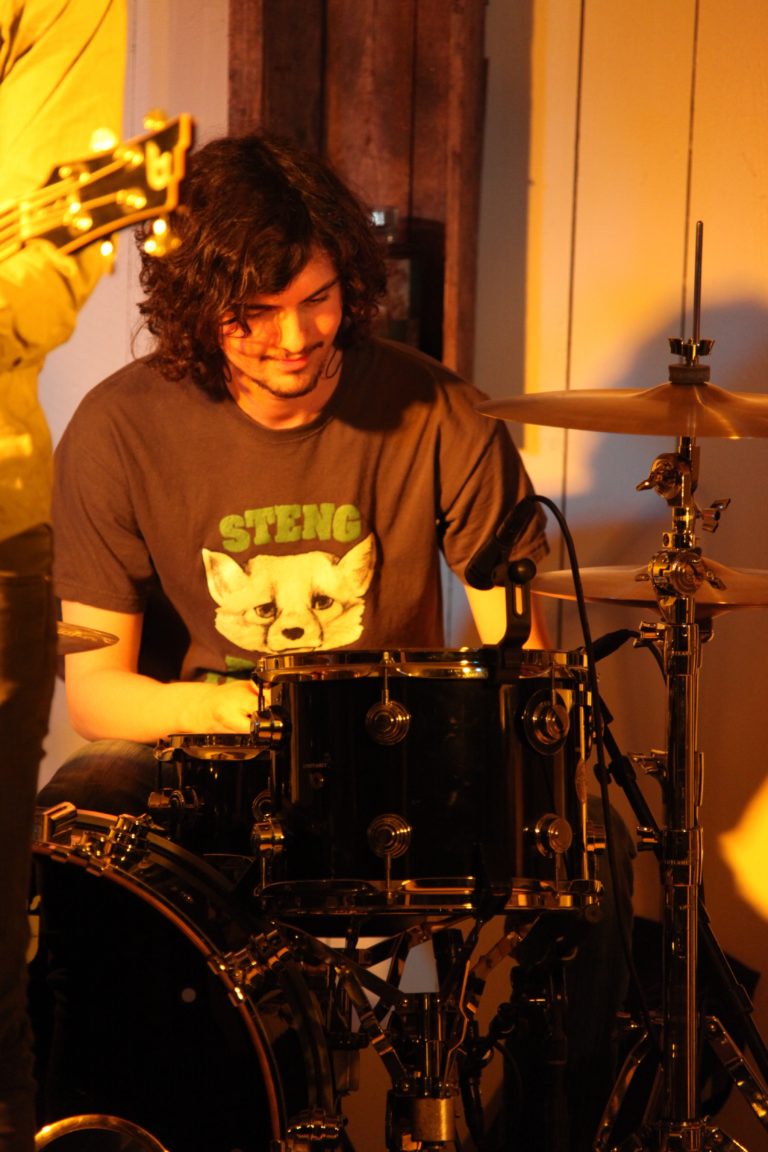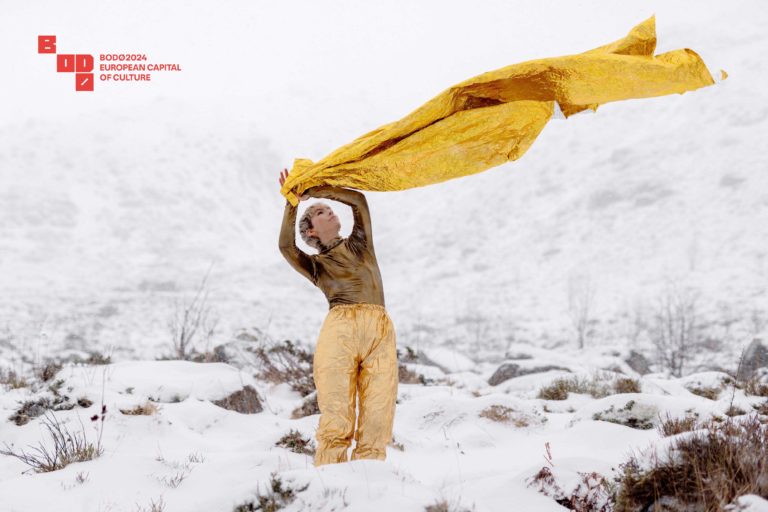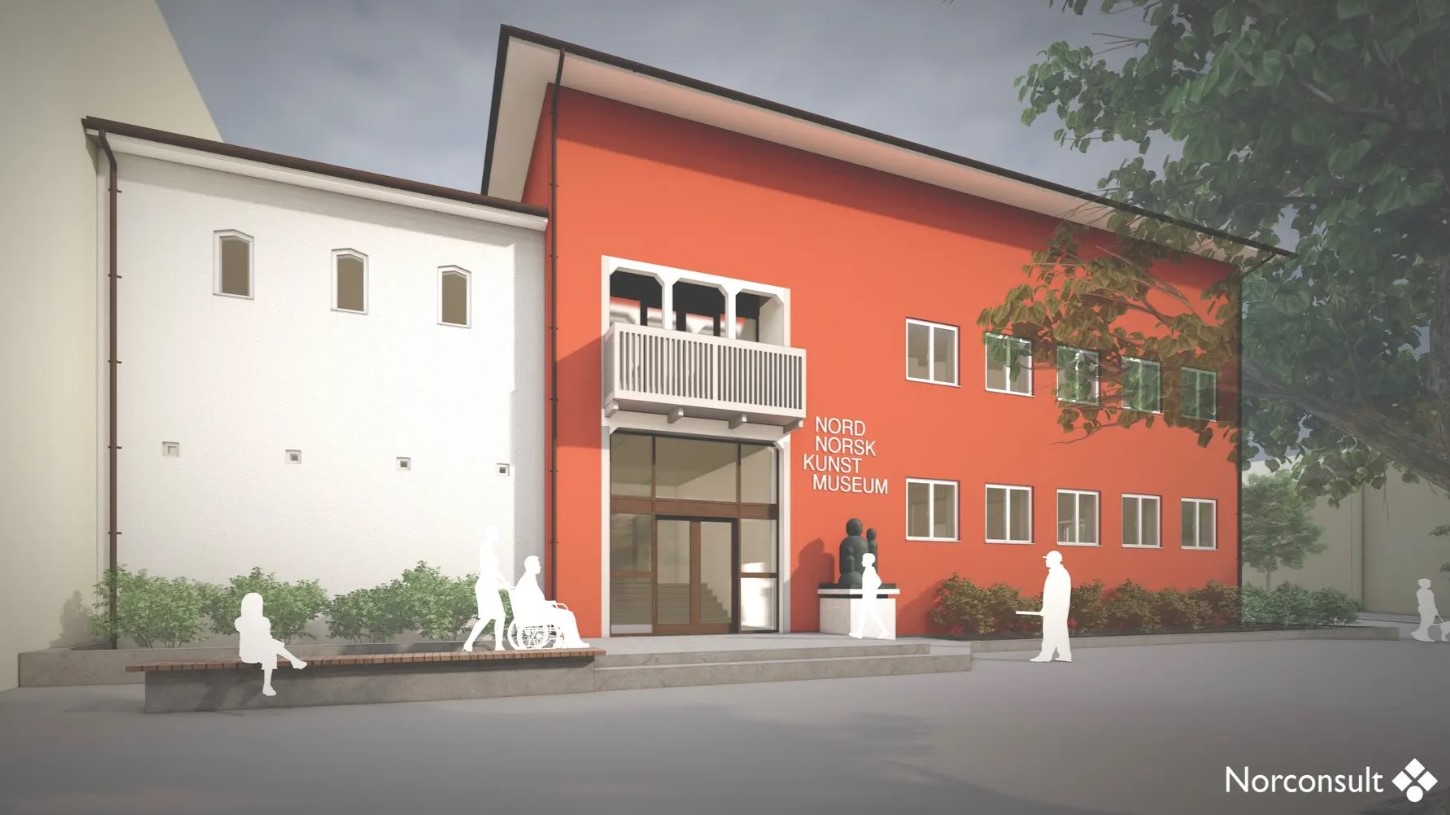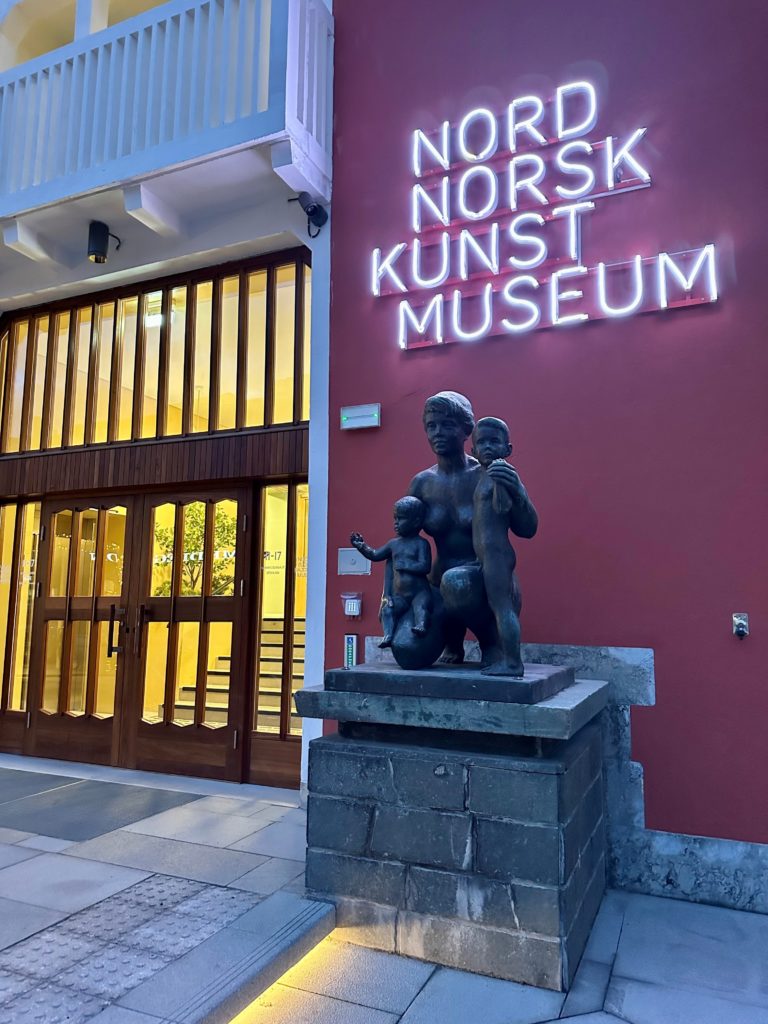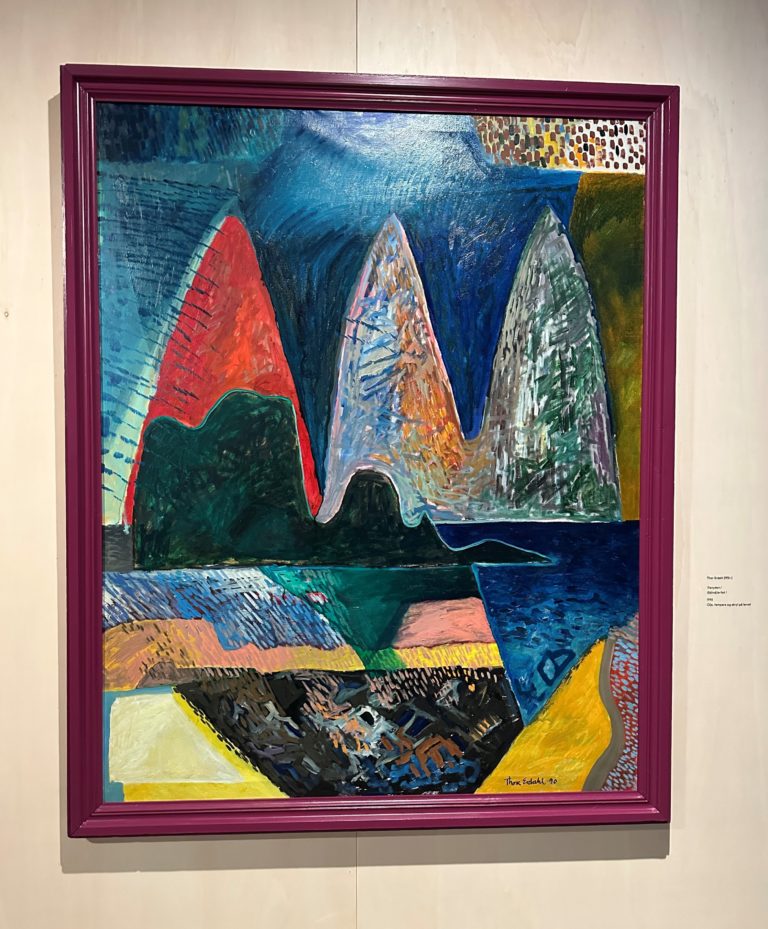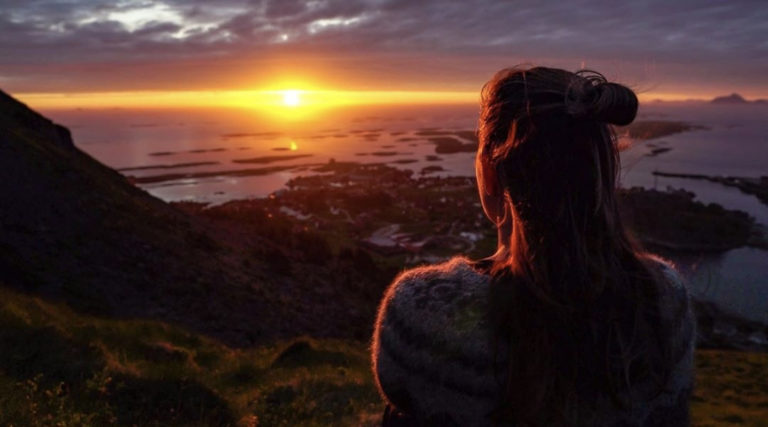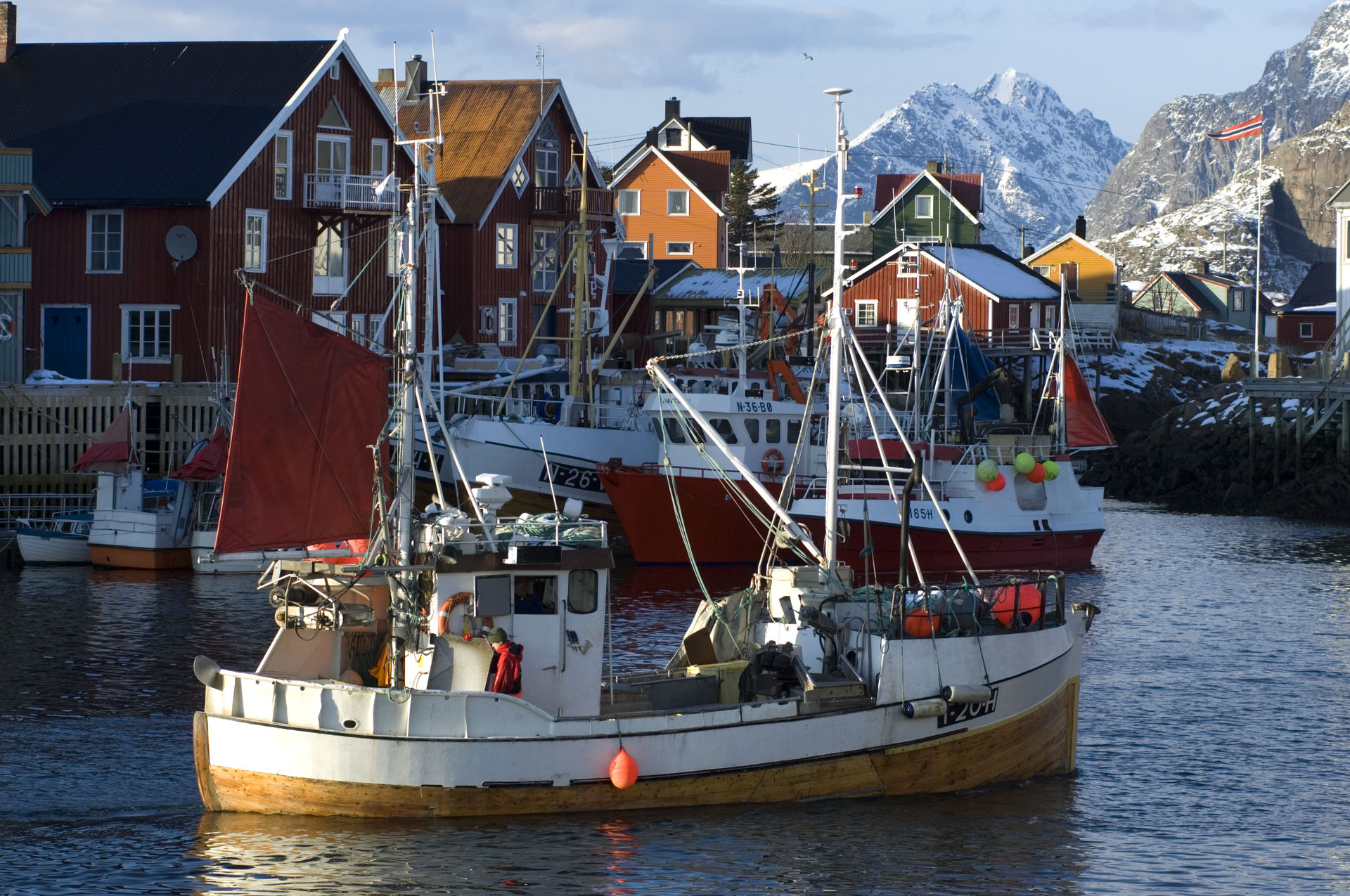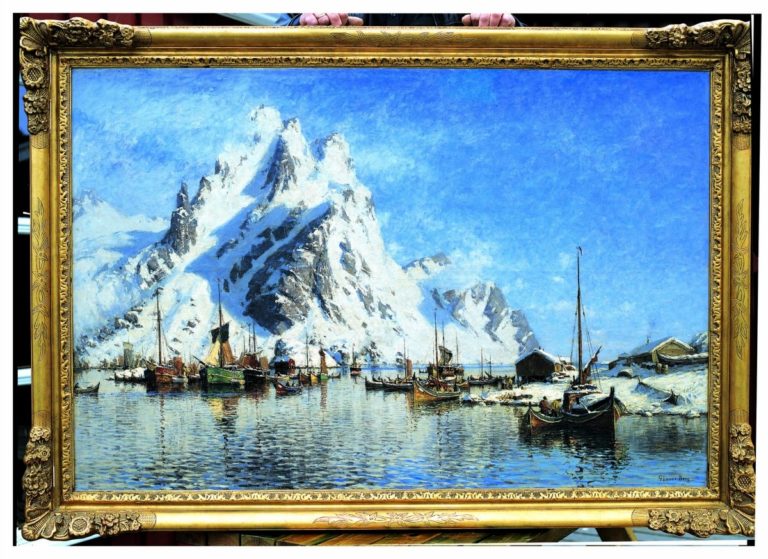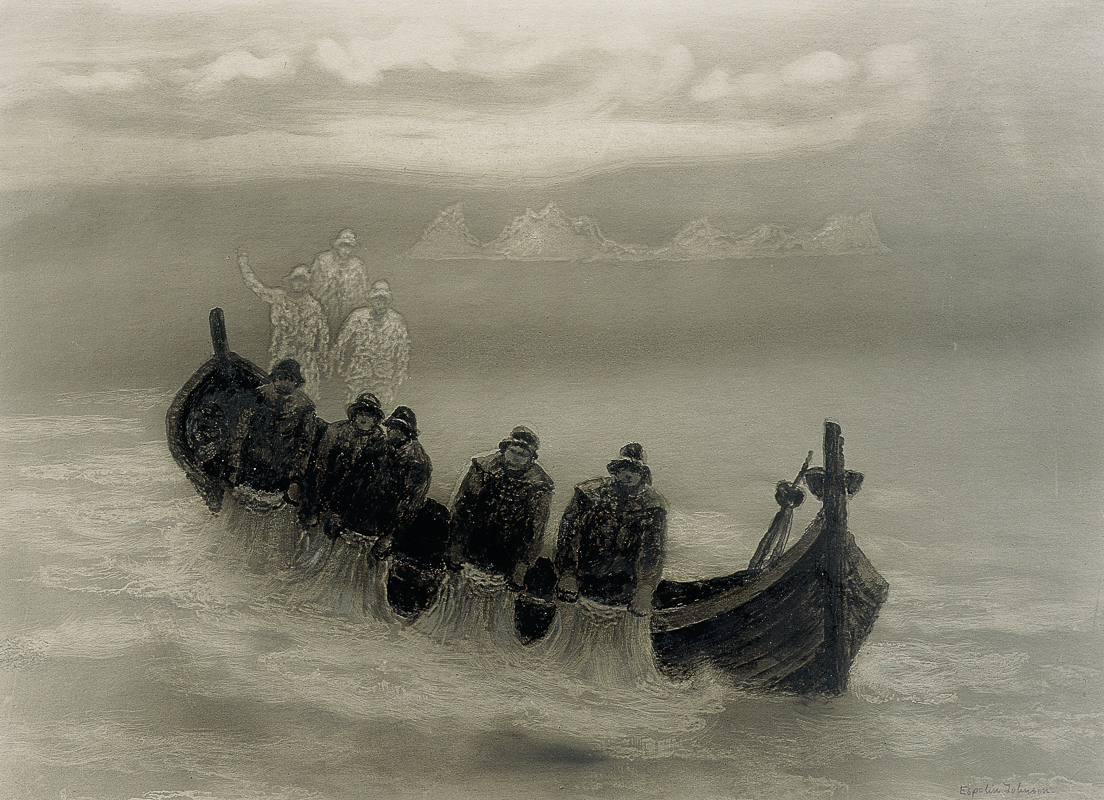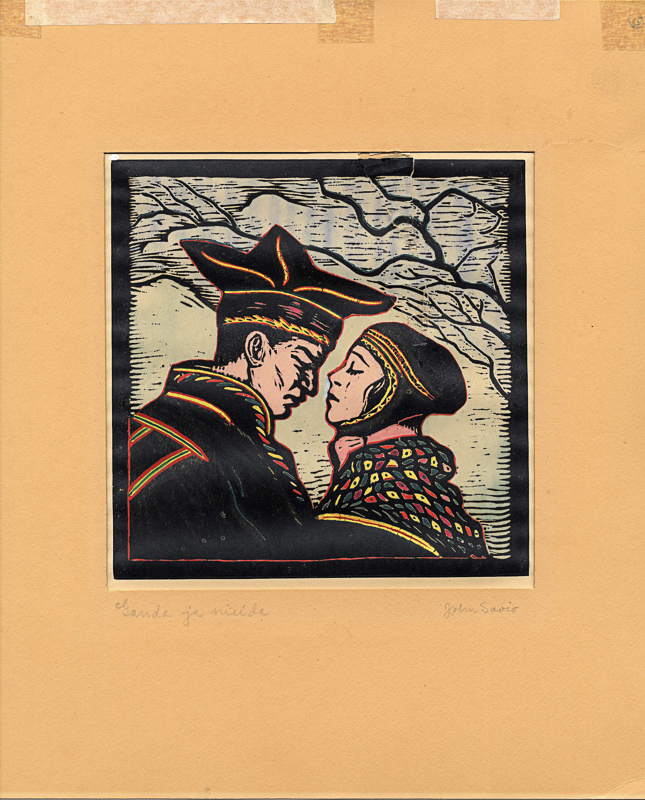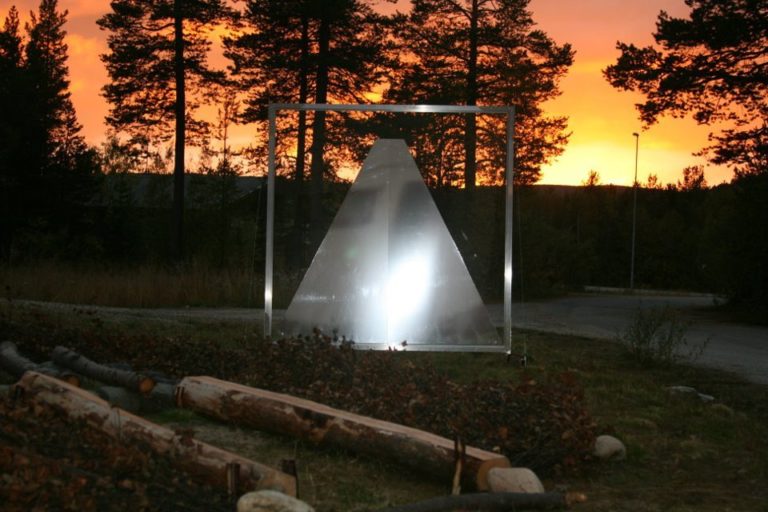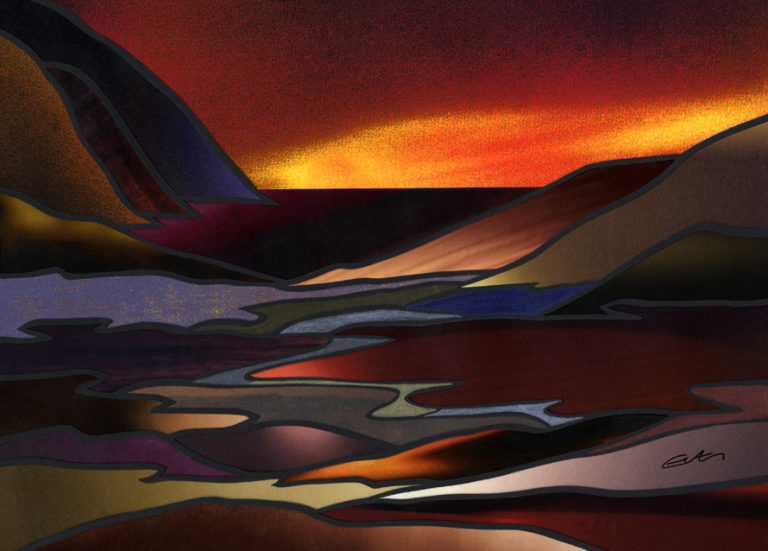A green flicker of the northern lights over jagged peaks, bright red fishermen’s huts and stockfish on the racks. Photographs of northern Norwegian nature act as a magnet for tourists these days. But painters have also contributed to creating international buzz about the scenic region and the people of the north. Northern Norway has fascinated and inspired creative souls for centuries.
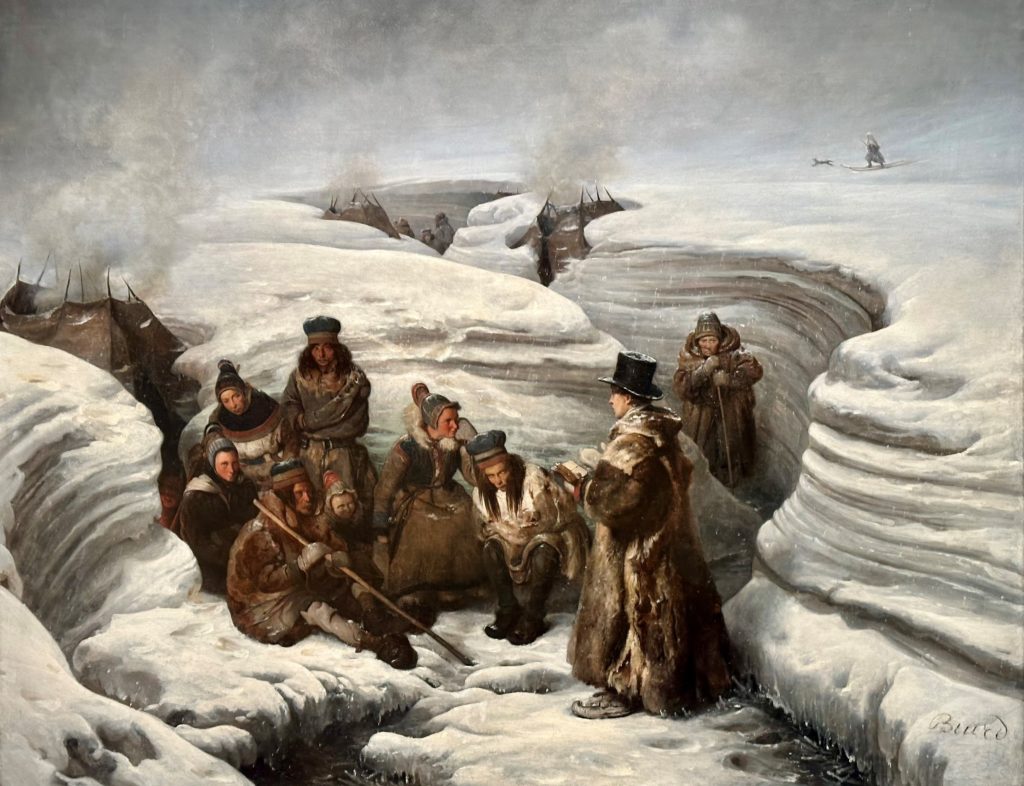
The poineers of visual arts in Arctic Europe
The visual history of the Arctic begins with map sketches and drawings, made by foreign scientists, explorers and travelers. Eventually, they also took their brushes and canvases up north. This period lasts around 300 years until photography gradually takes over as a tool for documentation and inspiration on their travels, from around the 1850s. The first foreign tourism is underway, and it all starts in the north!
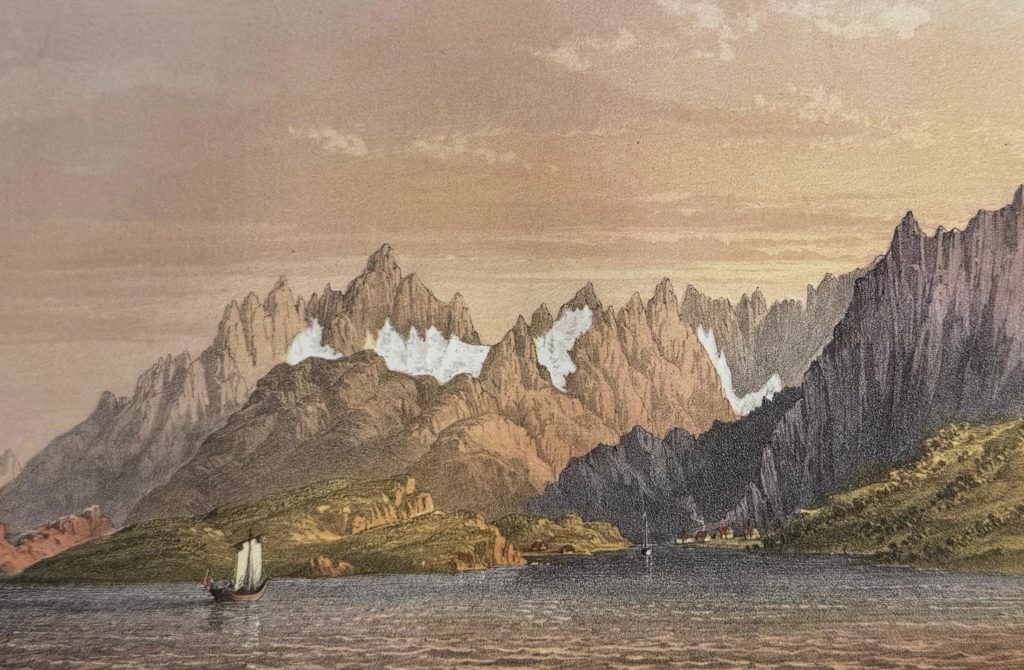
Motifs from the north primarily found their way into books, and for Norway, images from the north dominated almost completely until the beginning of the 19th century. In foreign book and map illustrations, Norway was represented with places up north, where Sweden was represented with Stockholm and Denmark with Copenhagen as place markers at this time! In the time of transition where romanticism is moving on, there are also different perceptions of what is beautiful:
Between the racks for drying cod stood some wooden houses, almost black with frost and damp. The place was no feast for the eyes. The Lofoten Islands are a chaotic pile of stone blocks, which must have been thrown together during one of the great upheavals of the Earth.
Leonie d’Auret in the early 19th century
There was dramatic nature, natural phenomena, stockfish, fisherman’s hut, hunting and fishing. Severe sea monsters and maelstroms off the coast of Northern Norway. Reindeer and the northern lights over the plateau were almost mandatory content in these travel books. Exotic descriptions of the people of the north, the coastal culture and the Sami way of life. This is how the northern regions were presented to a larger European audience and became decisive for their perception of Norway.
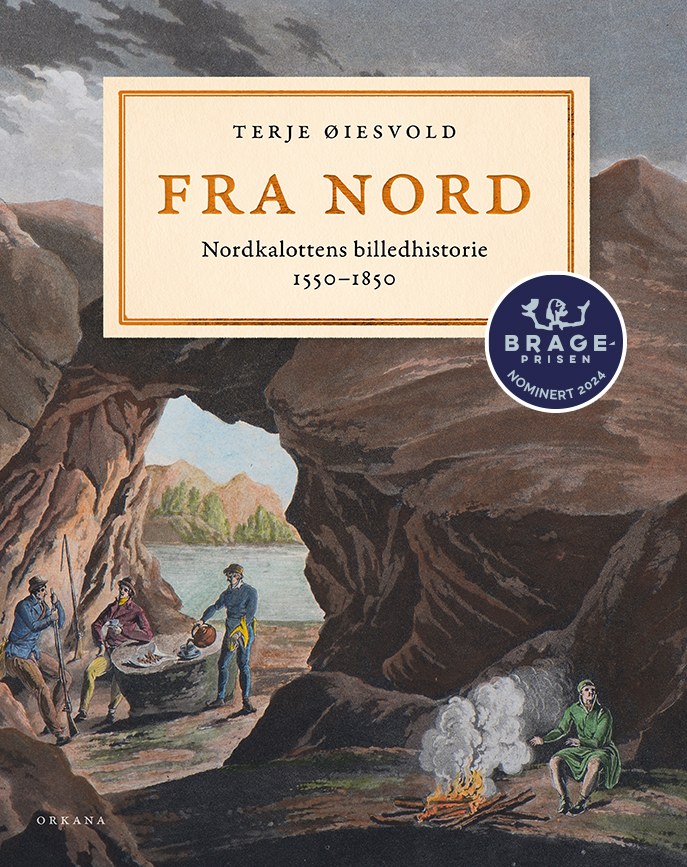
During the breakthrough of national romanticism between 1814 and 1905, little of this material was brought to light. The multicultural north did not quite fit into the search for a national identity. Coastal culture and Sami relations were overlooked in the new nation-building, originating in the new capital Christiania. Read more about this in the book “Mot Nord – Nordkalottens billedhistorie 1550-1850” by Terje Øiesvold.
The cultural travel suitcase

This article is one of several as a follow-up to Bodø 2024 – European Capital of Culture.
Read your favorite book, listen to your favorite artist and experience your favorite piece of art on this journey through our region:
Northward with easels and brushes
From the 19th century onwards, Norwegian artistic talents also began to travel north for inspiration, on study trips and in search of the best motifs for their canvases. Northern Norways’ own artistic talents often went further south at this time for education, inspiration and to learn from the old masters and new stars on the continent. With them in their luggage they not only had their northern Norwegian culture, but also their own experiences and impressions from the north that ended up on the canvas, presented to their fellow artists and art enthusiasts around Europe.
Furthermore, a small selection of “Northern Norwegian” classical painters who left a solid mark on our art history follows. This is not a complete list, but more of a comprehensive presentation of Northern Norway as an attractive travel destination for art enthusiasts. Feel free to click on the videos, and join us on a fantastic artistic journey north and back in time:
Peder Balke (1804-1887) from Helgøya in Mjøsa was one of those who was tempted north. Balke was a different painter and pioneer who combined the romantic movement’s attraction to naturalism with his own unique style. In 1832 he went on a long journey along the entire coast of Northern Norway, and for three months he was constantly exposed to spectacular nature all the way from Bodø, Tromsø, Skjervøy, North Cape, Vardø and to Vadsø. Balke had a distinctive style that may not have been recognized during his lifetime, but both “North Cape” and “Stetind in the Fog” are now recognized classics. See these masterpieces at the National Museum.
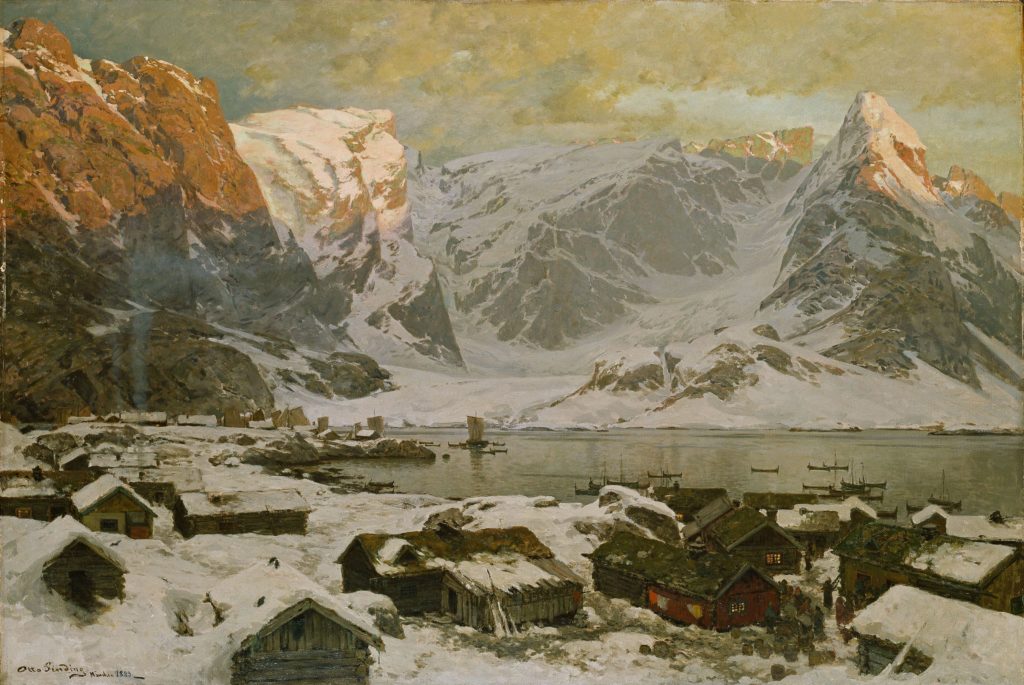
Otto Sinding (1842-1909) is another from the southern regions who found inspiration in northern Norway, and especially the landscape of Lofoten. He traveled on several study trips to Svolvær in the winter, and painted large landscape paintings from Lofoten. Sinding became well acquainted with Gunnar Berg (more about him below), and together with Peder Balke, the trio’s exhibitions in Germany with motifs from northern Norway are said to have attracted a lot of attention – and inspired a stream of other European painters to visit the region. A large collection of Sinding’s paintings with glimpses of winter life in Lofoten hangs at Galleri Lofoten in Henningsvær, including “From Reine in Lofoten”. After the 1880s, realism entered painting, which distinguishes Sinding from Balke.
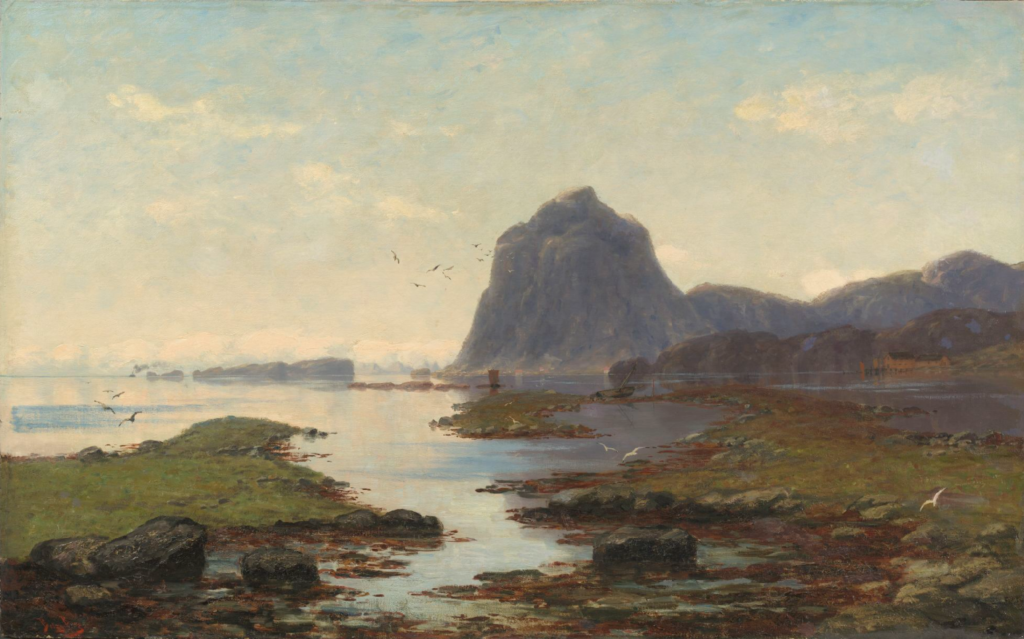
One of Sinding’s students, Betzy Akersloot-Berg (1850-1922) from Aurskog, was a hard-working plein air painter with an almost impressionistic brushwork. During a study trip to Vienna, she became interested in the art of the Dutch Hendrik W. Mesdag. She later moved to the Netherlands, but every year she traveled to her homeland, where she painted the coast from Lindesnes to the North Cape. She spared no effort to find her motifs and was out in all kinds of weather, usually wearing a southwester and a poncho.
Imperial influencer captured by our fjord landscape
The Nordland coast undoubtedly has a fjord landscape that captivates. While visiting artists had long since begun to travel to Northern Norway in search of inspiration, Eilert Adelsteen Normann (1848–1918) from Vågøya outside Bodø also realized that the surroundings in which he grew up were well suited for artistic interpretations. The painter was strongly influenced by the national romantic superstars Hans Gude and Adolph Tidemand – and would himself become a mentor to Edvard Munch himself. Normann opened the door to the world when he invited the then unknown Munch to exhibit in Berlin in 1892. The exhibition became a scandal, but Munch gained his fame, for which he could thank the “Gentleman from Vågøya”.
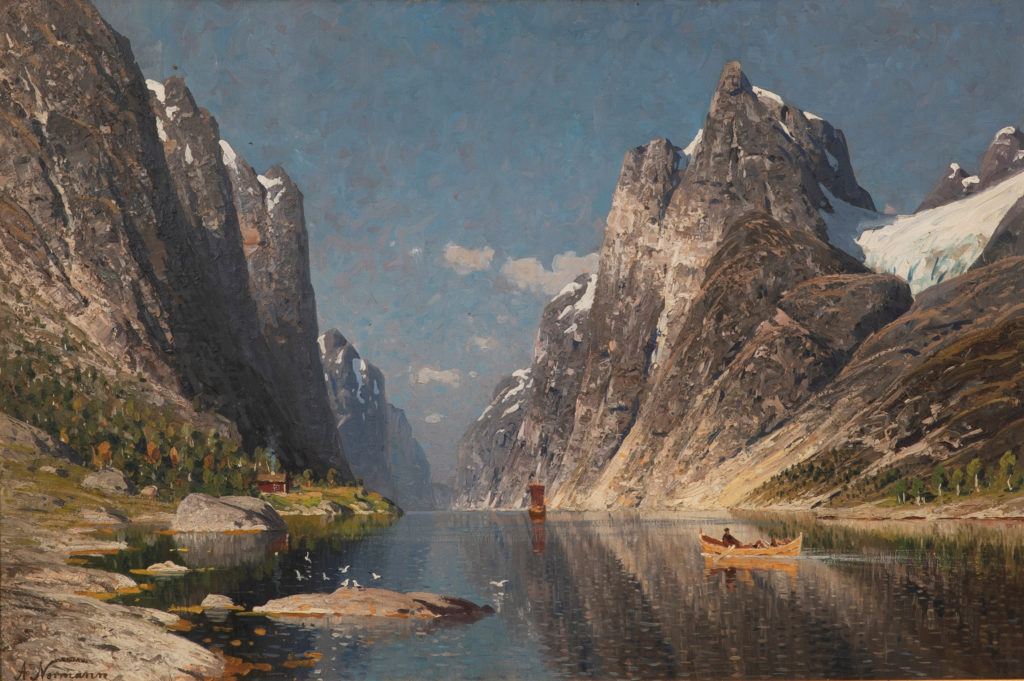
He moved to Germany to seek his fortune at the art academy in Düsseldorf in 1869, and later settled in Berlin. But the fjords and mountains of northern Norway were always present when Normann painted. The special light was a clear source of inspiration, and the painter also included steep mountain slopes and small houses – often under the eternal sun of the midnight sun. In fact, it was the art community in Germany that ensured that Norway ended up on the international tourist map. The German landscape painters Josef Krieger and Johann Adalbert Heine had previously been on an inspirational journey to northern Norway and painted what they saw.
The romantic motifs and color choices gave the Düsseldorf painters the somewhat derogatory name, criticized in their time as conservative and commercial. For other artists and art connoisseurs who had not experienced Fjord and Northern Norway in reality, these pictures were considered unreal, but the classical pictures reached a much wider audience than the new fashion trends in the visual arts. Not unlike what many of today’s influencers experience when they share photos from here:
Normann’s large fjord picture attracts general attention from foreigners, and one often hears them, upon viewing it, express a desire to visit a country that is so beautiful… but especially the mountain wall in the foreground and the mountain ranges beyond seem artificial and overly decorative.
Morgenbladet’s correspondent reviews the World Exhibition in Antwerp 1885
When Emperor Wilhelm II saw their motifs from Lofoten, and especially Digermulen on Hinnøya, at an exhibition in Berlin in 1888, it was in many ways the start of international fjord tourism in Norway. The emperor was deeply fascinated, and decided to see with his own eyes whether the landscape was really as beautiful as the art suggested. Not long afterwards, he was in place in the Norwegian fjords with the ship “Hohenzollern” – a journey he would repeat every summer for decades, and which made Norwegian holidays trendy among the elite throughout Europe.
The most valuable piece of art found in the home and dream land of The King of Pop – Michael Jackson’s Neverland was a large painting by Adelsteen Normann!
From the podcast “Under the Midnight Sun” by The Lonely Palette
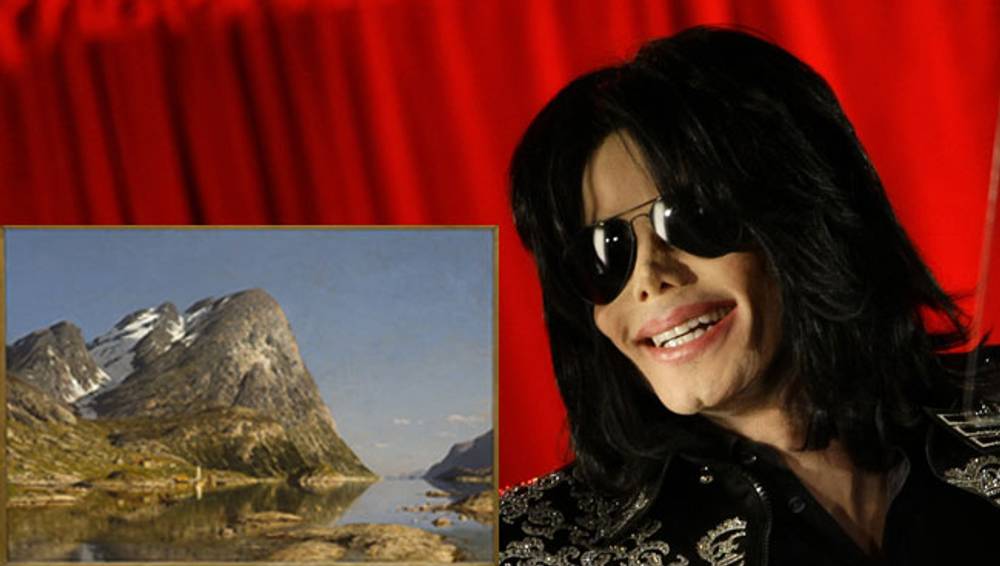
Eilert Adelsteen Normann must have acted as a kind of ambassador for tourism to Norway. The artist from Bodø often spent part of the summer in northern Norway. Here he drew sketches and took photographs as the basis for large-format landscape paintings, including “Fiskevær in Northern Norway”. In 1890, the German emperor bought his first painting by Normann from an exhibition in Berlin. Later, he was to commission a three-meter-large painting of the Lyngen Alps, but due to the outbreak of World War I, this was never delivered to the emperor. Read more about our great artist at Wikipedia.
New art museum in Nordland!
NordNorsk KunstMuseum Bodø opens on February 25, 2025, in the brand new branch in the old Savings Bank building in Bodø, and in the fall there will be a major solo exhibition with works by “The Gentleman from Vågøya”. Adelsteen Nordmann is represented in museums, galleries and collections in Europe, the USA and Canada. Today you can experience the art collection of Adelsteen Normann Stiftelsen on the walls of Haalogatun. The collection now consists of 50 paintings and 23 pencil sketches.
From realistic to romantic on the Helgeland coast
Knut Baade (1808-1897) from Rogaland also made a name for himself with art from the north. “Øya Træna i Nordland” (The Island of Træna in Nordland) shows a ship in rough seas on the Helgeland coast. Many of Baade’s somewhat gloomy paintings have maritime themes, including several variations of “Shipwreck”. Read more about his art at the National Museum.
Even Ulving (1863-1952) from Ylvingen on the Helgeland coast began his career as a craftsman painter, but traveled to the art center in Kristiania to study fine art painting when he was 18 years old, and was a student at Knud Bergslien’s painting school, among other things. He later studied art in both Germany and France, and in his large production, naturalistic paintings are motifs from the Helgeland coast a recurring theme. In 1889 he traveled to Henningsvær. “Fiskevasking” and “Henningsvær harbor” are clearly inspired by his time in northern Norway, and the artist himself was present during the Lofoten fishing with brush and canvas.
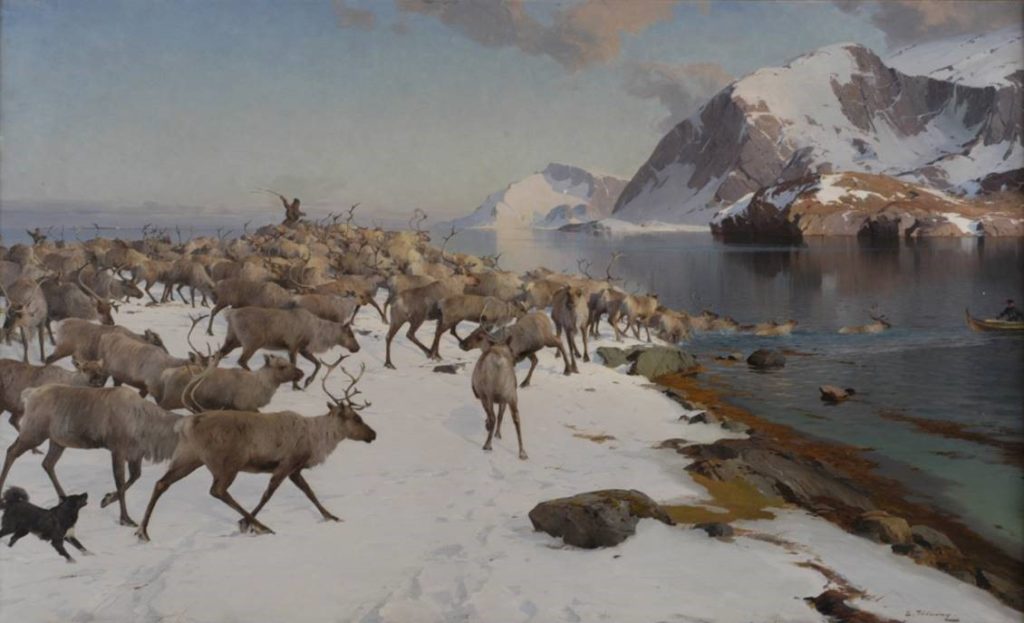
Ulving from Ylvingen is considered one of Helgeland’s most prominent painters of all time. The painting “Reindeer in a Winter Landscape” depicts the Sami reindeer migration, which also has a long history in Helgeland. The spring sun shines through as the animals swim in the cold sea. The artist reminds us of the close interaction between humans and animals in the ancient and magnificent landscape. Read more about this work on the Facebook pages of the Royal Collections.
Thorolf Holmboe (1866–1935) grew up on the Helgeland coast, but moved to Tromsø when he was 10 years old. Here his father was an art dealer and established the Tromsø Kunstforening. Thorolf eventually traveled to Berlin, where he was the last Norwegian student to be apprenticed to Hans Gude. Helgelendingen’s works are considered part of the neo-romantic movement, and are mainly paintings of northern Norwegian landscapes. However, he was a versatile artist who also dabbled in drawing, illustrations, book art and vase decoration. See more of his art at Gallery Lofoten.

Bjarne Ness (1902 – 1927) was born in Trondheim and died quite young. His parents were both from Vega on the Helgeland coast, where Bjarne spent every summer as a young man. He was born with a pencil in his hands, and later studied with Axel Revold at the School of Arts and Crafts. His many summer stays at Vega were of great importance to his art.
Nordland – where people are naive and don’t expect that much like us, where nature is rich and mysterious, where there is magic in the atmosphere
Bjarne Ness in a letter, in line with the family’s rich storytelling tradition
There he roamed around Vega, in the most beautiful landscape, with livestock, sheltered coves, small idylls and high mountains, over all this wonderfully clear light.
Art collector Håvar Grøttland, about Bjarne Ness from the book “They Painted Nordland”
The Lofoten painters become a concept
The term “Lofot painters” was also a term used for artists who came from the south and found motifs in the northern Norwegian nature. Northern Norway had a great influence on, among others, a cultural celebrity from Oslo and a popular artist from Kragerø. The influential artist Christian Krogh (1852-1925) became interested in drawing and painting at an early age, and was a well-known journalist and writer. He traveled north during the Lofoten fishery in 1896. His painting “Burial in Nordland”, where the coffin is carried out in the Nordland boat, while the flag is hoisted at half-mast outside the house in Svolvær, is one of his famous works from here.
An impressive sight, the purest of the pure, the coldest of the cold, the most virtuous of the virtuous, the most noble one can imagine. The city does not enter, but fades into the landscape as the painters say. There may well be color in a painting of these mountains.
Christian Krogh in his description of Svolvær and the breathtaking nature of Lofoten.
Around the same time that Normann and Krogh were using their brushes to immortalize the dramatic landscape and the powerful light, Theodor Kittelsen (1857-1914) made a name for himself as an illustrator of Norwegian folk tales. But Kittelsen was also captivated by the mountains and fjords of Norway, and during a stay at Skomvær lighthouse in Lofoten he painted the oil painting “Echo”, which was shown at the World Exhibition in Paris in 1889 – the same event where the Eiffel Tower was completed. In the north he created several drawings later published in book form, including “Fra Lofoten 1” and “Fra Lofoten 2” from 1889-1890. Read more about his stay at Skomvær and Lofoten pictures at Archive in Nordland.
In addition to capturing the nature of northern Norway on canvas and captivating one of the great celebrities of the time with his art, Normann inspired Gunnar Berg (1863-1893) from Svolvær to travel to Düsseldorf to study art. Berg was to become one of the great painters of Lofoten, although he died of cancer at the age of 30. His portfolio includes many motifs from northern Norway, where fishing boats and mountains are in harmony. There is also a more serious undertone, exemplified in the painting “Trollfjordslaget” which is currently on display at Gallery Gunnar Berg on Svinøya in Svolvær. Berg was also an avid photographer, and many of his photos are part of the exhibition in his hometown.
Svinøya’s artist with his own gallery
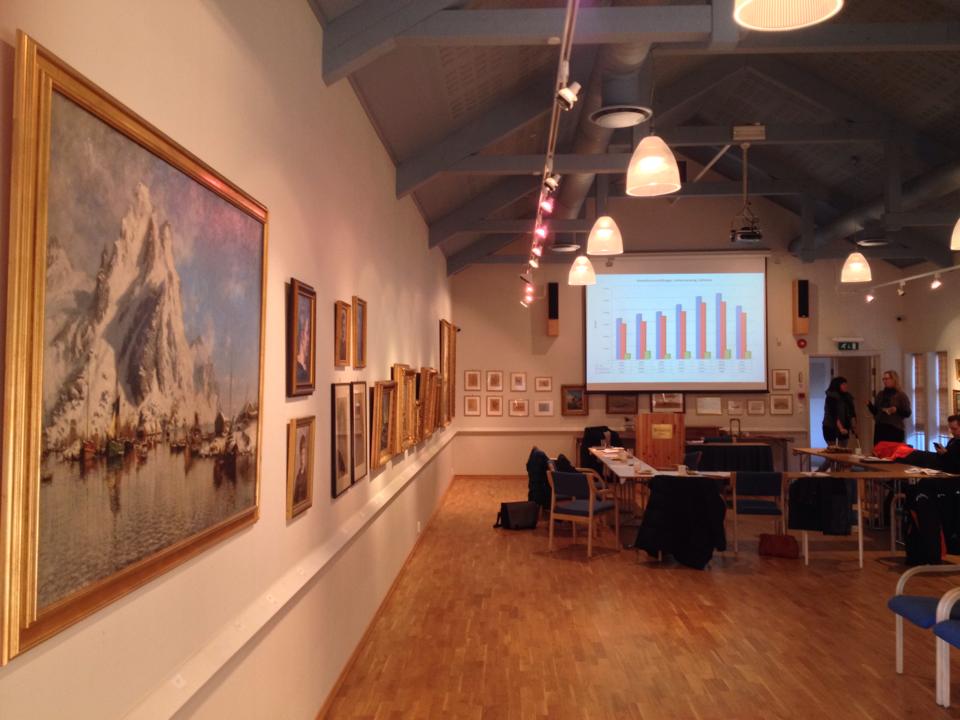
Gallery Gunnar Berg houses an impressive collection of his works. The jewel in the collection is the Trollfjord Battle. In the gallery we find almost 70 oil paintings and several pencil sketches. Several beautiful photographs taken by the artist in the period 1882 – 1892 can also be viewed, including the camera that was used. There is also a conference room here.
Ole Juul (1852-1927) grew up on a farm in Dypfjorden near Henningsvær in Vågan. Inspired by his cousin Eilert Adelsteen Normann, he traveled to Düsseldorf to attend painting school. Juul never had a major breakthrough as an artist, but at the very end of his life he unexpectedly and somewhat by chance received the recognition that makes him today considered a significant artist. It was not until the age of 70 that he was “discovered” through a major exhibition in Oslo, after which art critics in Dagbladet wrote about a painter “of considerable talent”. See more about him at Gallery Lofoten.
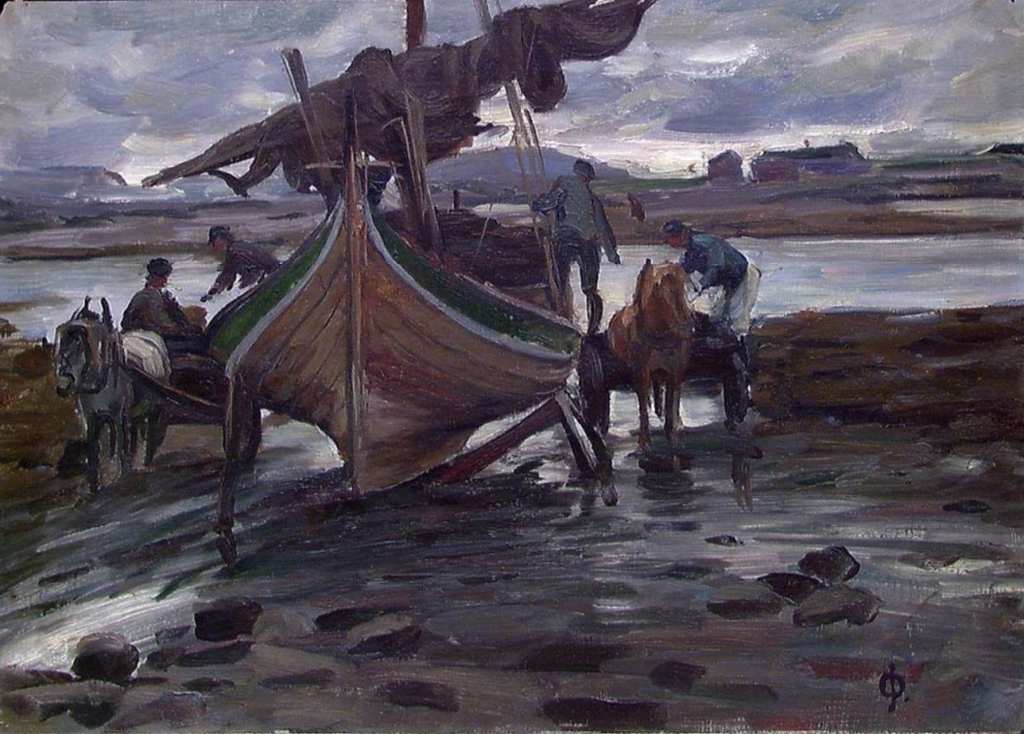
Anna Boberg (1864-1935) from Sweden was a self-taught artist, who only gained acclaim for her art long after her death. Boberg was deeply fascinated by the northern lights and the midnight sun, and visited Lofoten dozens of times to paint and find inspiration. Her work has been given new life through the Swedish National Museum in recent years.
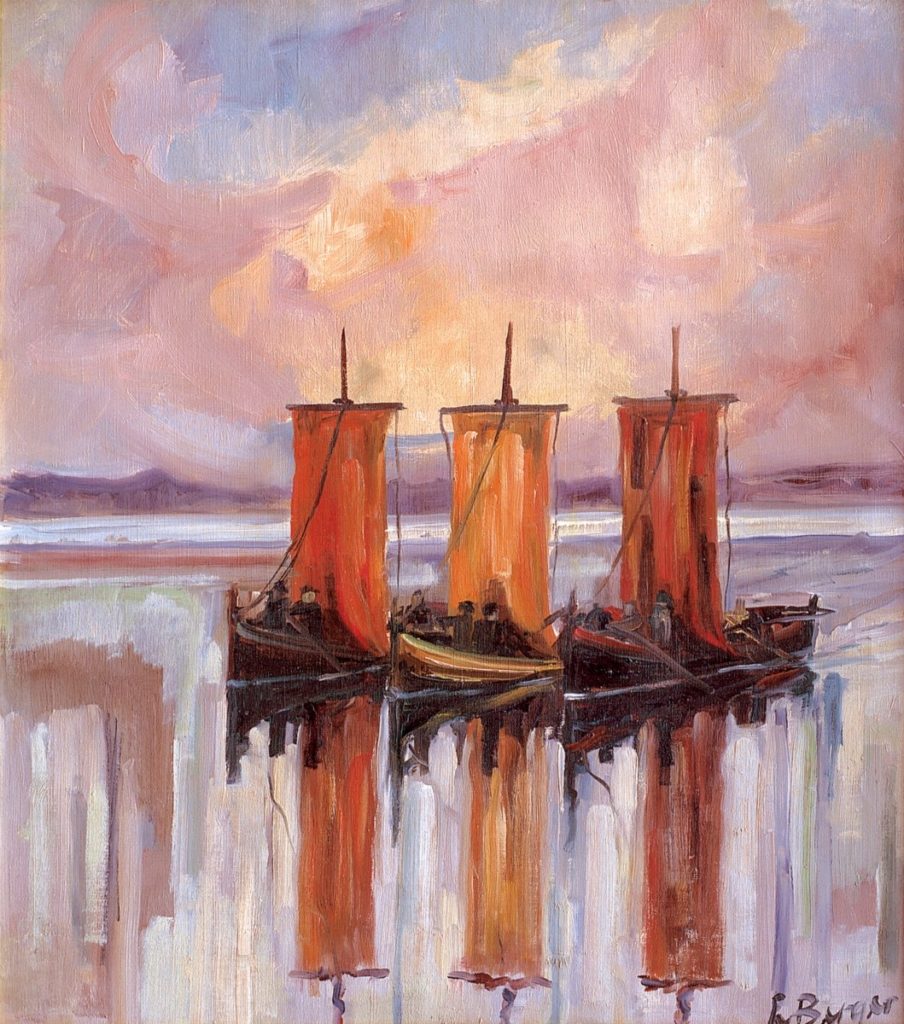
Einar Berger (1890-1961) from Reinøy north of Tromsø had a somewhat unconventional path into the world of art. Like so many other boys from northern Norway, he went to sea to participate in the Lofoten fishing at a young age, and later became a fishmonger in Oslo. However, the business did not go well, and even without any formal artistic education, Berger began to paint. Being self-taught at this time was not necessarily positive for his reputation, and he had to work extra hard to gain recognition for his art – with his expressionistic expression influenced by his time in the north, he was also different from the other “Lofote painters” in style. Read more about him at Gallery Lofoten.
Henningsvær has gathered the Lofoten painters
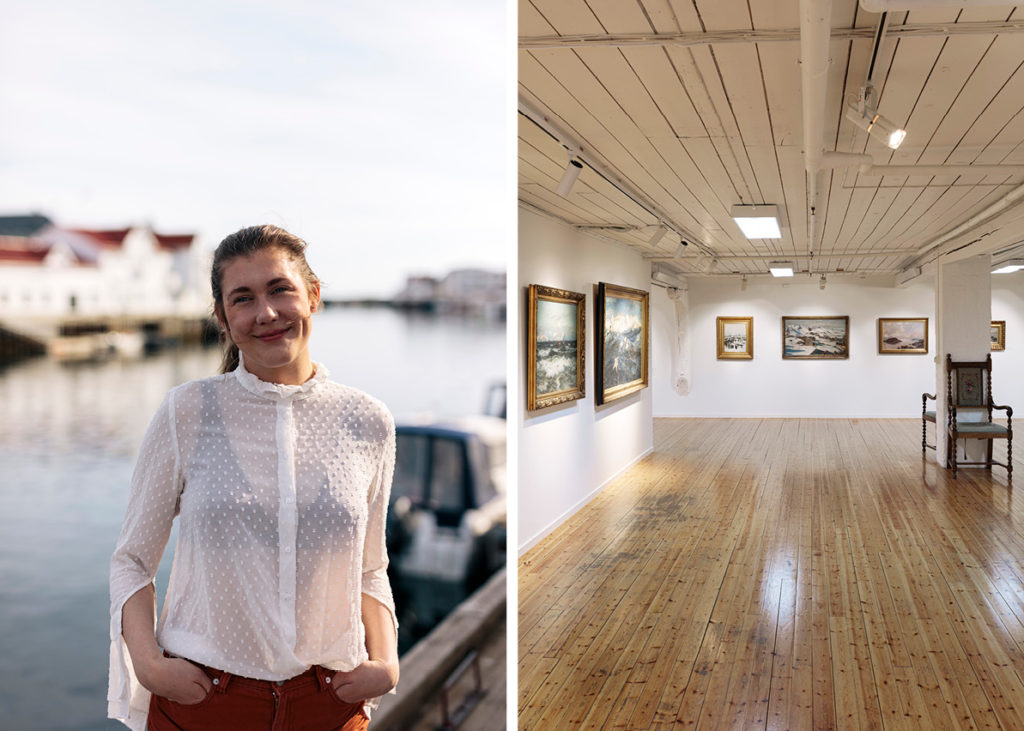
Gallery Lofoten has the country’s most comprehensive exhibition of Northern Norwegian paintings from the period considered the golden age of Northern Norwegian painting, including several local artists who received national and international recognition. Here you will find paintings by Otto Sinding, Thorolf Holmboe, Ole Juul, Anna Boberg and Einar Berger, among others.
Halfdan Hauge (1892-1976) from Svinøya in Svolvær grew up in a time when the surroundings he walked around in everyday life were sought-after art motifs. Although he began his professional life as a cooper and shoemaker, he eventually became a full-time artist, and most of his works depict life in Svolvær. Read more about him at Norwegian Art Encyclopedia.
From fishes to frescoes
Axel Revold (1887 – 1962) came from Narvik, started at the Royal Norwegian School of Drawing and moved to Paris to study, where he met Henri Matisse who played a decisive role in Axel’s artistic choice. In the interwar period came the “fresco era” (Italian for “the fresh”), which made it possible to paint directly on plaster. This led Axel on the path of decorating public buildings with his frescoes. In a stairwell at a primary school there hangs a large painting called “Nordlandsnatt” and shows a young couple on a bright Nordland summer night. The colors are strong and the motif is simple in form; Axel’s signature expression. “The Return of the King” hangs in the palace, and “Greetings to the People of Nordlands” hangs in the old Nordlandsbanken, now Bodø District Court. See more of his art at the National Museum.
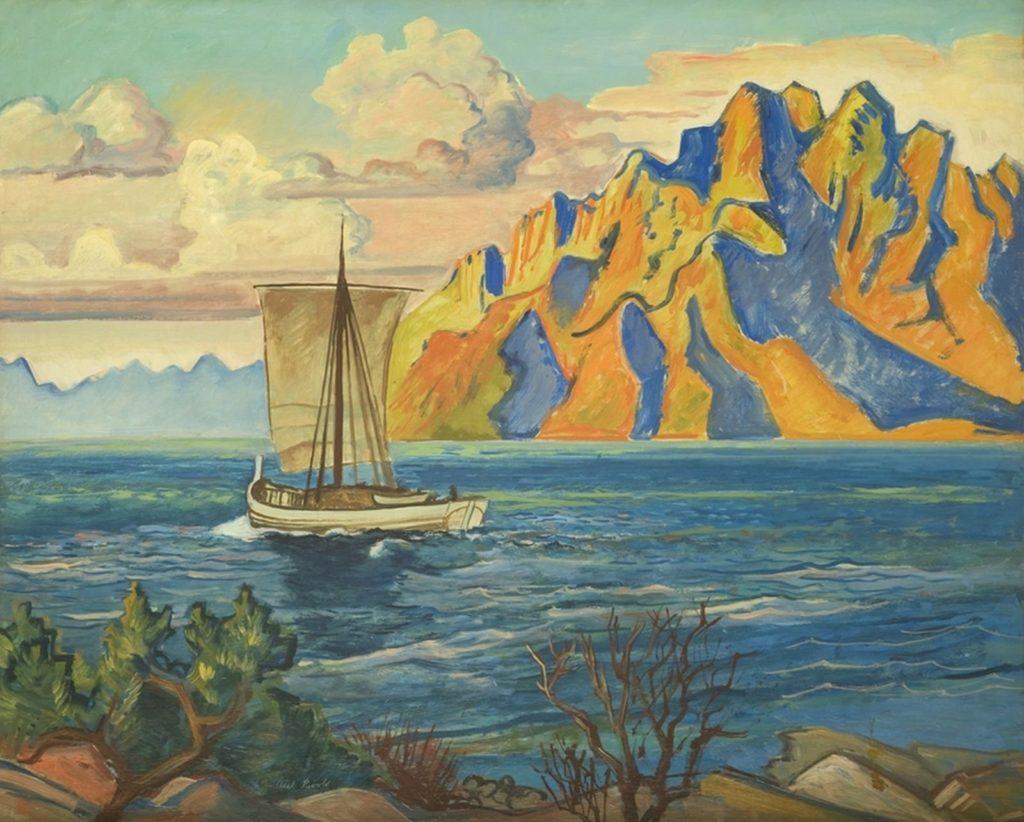
Odd Helmersen (1922 -2012) debuted as a painter with a couple of small solo exhibitions in Svolvær right after the Second World War. Without having any form of education, he showed a number of works in watercolor and oil here. He received education from the Swedish painter Åke Corshammar, studied in Paris in and at Bjarne Engebret’s painting school in Oslo in the 1950s. His motifs are mostly taken from his hometown of Svolvær. In his works, he showed greater concentration on light and more conscious use of the coloristic expressive possibilities, and received the State’s guaranteed income for artists from 1978. Read more about him at Archive in Nordland (watch the video there; the segment with Odd starts about 11 minutes into the film).
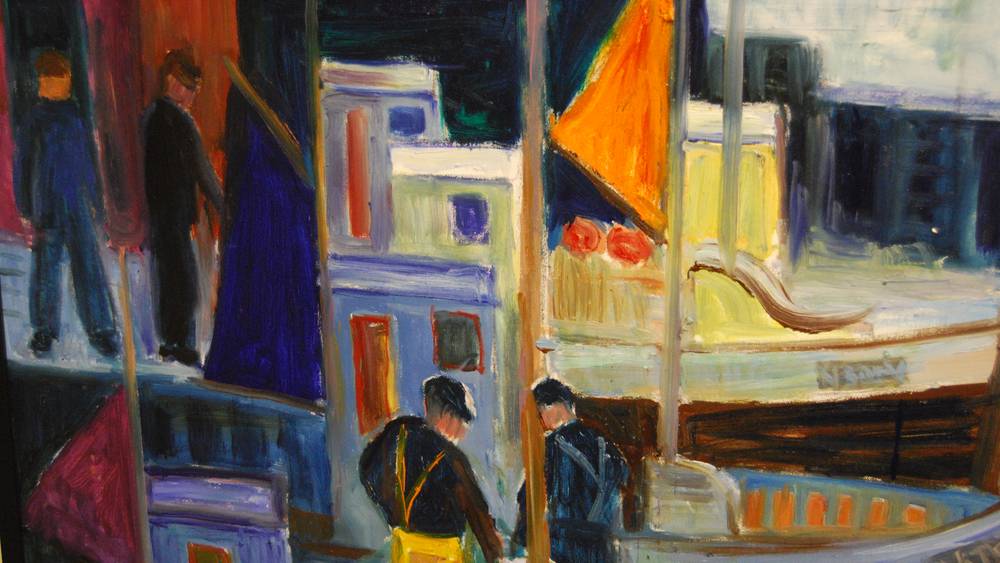
Rugged, weathered, over the water
Perhaps it was because of the magical landscape that the Lofoten painters went a little against the grain and chose the romantic style – which was not really the big trend among painters. Eventually, the harsh nature would also inspire another type of artist.
Perhaps it was because of the magical landscape that the Lofoten painters went a little against the grain and chose the romantic style – which was not really the big trend among painters. Eventually, the harsh nature would also inspire another type of artist.
Kabelvåg showcases an influential artist
Maritime themes also characterize the style of Kaare Espolin Johnson, but the paintings at Galleri Espolin in Kabelvåg have a more dramatic expression. The artist himself had Icelandic ancestry, and the gallery in Kabelvåg is designed with clear inspiration from Icelandic architecture.
Lars Lerin (1954-) from Värmland in Sweden is a visual artist and author. He lived in Lofoten throughout the 1990s, and his watercolors stand out from most of the other painters who laid the foundation for Northern Norway’s status among artists in the previous century. Lerin chooses the dark and mysterious over the “postcard motif” of Lofoten, but mountains, birds and fishing are still often included – always with the Swedish artist’s distinctive eye for light. Lerin has also written and illustrated a book about his encounter with the region; “Lofoten” from 2023 (in Swedish). Read more about him at Gallery Lofoten.
Open landscapes and wide canvases
Northern Norway is much more than dramatic mountains and rich coastal culture. The region also consists of inland and plateaus, and is about both reindeer herding, Sami culture and open landscapes. One of them was Gustav Adolf Mordt (1826-1856) from Oslo. He was educated at the Academy of Fine Arts and Copenhagen and with Hans Gude in Düsseldorf. But it was on the plateau in Finnmark that he found inspiration. Mordt mainly painted romantic landscapes, and has several motifs with reindeer grazing in beautiful surroundings in Northern Norway. See more of his paintings at the National Museum.
John Savio (1902-1938), from Sør-Varanger, is particularly well known for his woodcuts. These are considered the first modern Sami artistic expressions, and give us a unique insight into Sami everyday life from the early 20th century. The images are often simple but strong, in woodcuts that show reindeer on the plateau, wolves, solitary trees and Sami spitz dogs. Savio was never recognized in his own lifetime, which was marked by both poverty and illness. However, he is now hailed as a great artist, represented, among other things, in the National Museum in Oslo with over 100 works:
Kirkenes – borderland for Sami art
In 1994, a separate Savio museum was opened in Kirkenes, and with a solid collection of his works, this is the best place to get to know the art of the Sami artist and graphic artist:
The museum is temporarily located in the Borderland Museum in Kirkenes and currently manages the largest collection of John A. Savio’s art.
Nils Nilsson Skum (1872-1951) also depicted reindeer herding in his art. The Swedish-born reindeer herding Sami, who was born during the spring migration from Kautokeino to Gällivare in Sweden, developed his artistic skills without the help of others. He depicted the life of the Sami in drawings and pastel paintings, often in a simple style, but with a clear eye for peculiarities. Skum also published several books about life on the plateau.
Iver Jåks (1932-2007) from Karasjok also came from a family that herded reindeer, but when he was 8 years old and seriously injured his foot after driving reindeer, it became clear that life as a reindeer herding Sami was not going to be his path in life. The young man from Karasjok went via the Sami folk high school in Karasjok to the State School of Crafts and Art in Oslo and the Academy of Fine Arts in Copenhagen. He married the Danish artist Inger Nielsen, who was 12 years his senior, and moved to Tromsø in 1991 after living in Karasjok for a long time. As a draftsman, sculptor and painter, Jåks was interested in Sami traditions. He often used natural materials such as leather, wood, horn and bone, made drawings with charcoal and ink, watercolors and graphics, and also produced large-scale sculptures in wood and concrete. See more of his art at the National Museum.
Per Adde (1926-2020) and Kajsa Zetterquist (1936-) originally came from Sweden, and established themselves in Saltdalen in the 1960s. Here they built a home and studio in a valley, where they found inspiration in the scenic surroundings. Both Adde and Zetterquist have an expressionist painting style with strong colors. The couple helped start the Kabelvåg Art School in 1983, as well as the Nordnorsk Art Center in 1973. In addition, Adde in particular has been involved in the fight for the rights of the Sami population, nature conservation and art policy.
Storjord in Saltdal – a hotbed of nature and cultural history
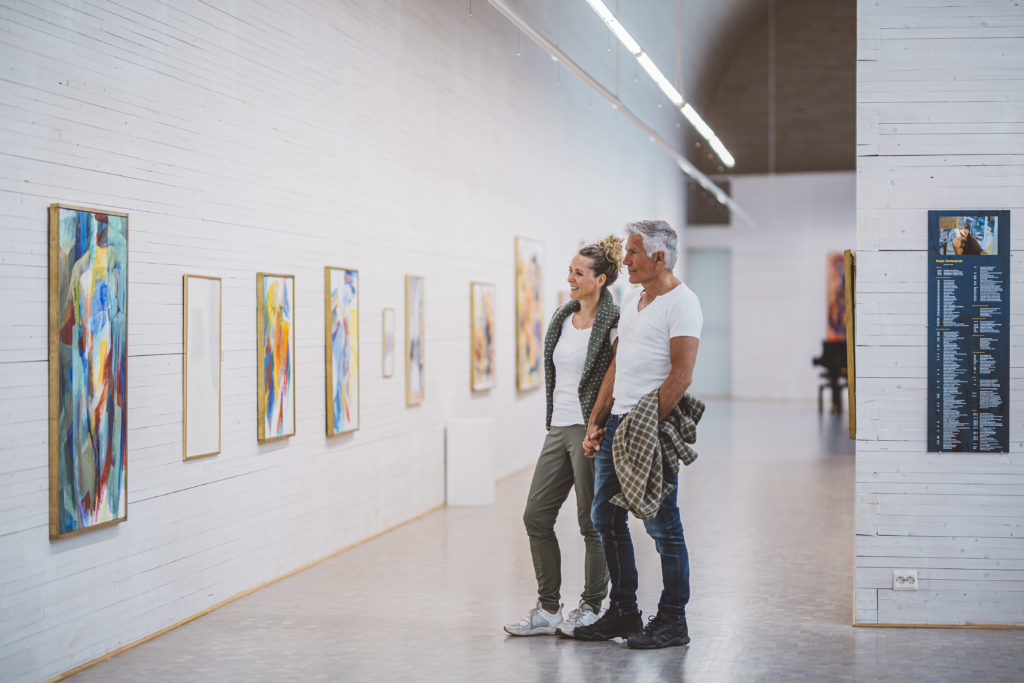
The Adde Zetterquist Art Gallery is a harmonious building, and its purpose is fittingly to convey the artist couple’s commitment to protecting both nature and culture. It is also part of Nordland National Park Centre.
From light and waves, to reflection and abstraction
Oscar Bodøgaard (1923-2011) from Bodø was known as the “painter of light”. That’s almost how it must be when you grow up between the jagged peaks of Børvasstindan and the horizon of the great ocean. Bodøgaard was educated in art in Trondheim, Oslo and Copenhagen, but settled at home in Bodø where he became a prominent figure as an artist. Bodøgaard interpreted nature in his own way. His artistic expression was always evolving, from the naturalistic figurative in the early phase of his life and on to more abstract interpretations of light seen through the seasons.
Bodøgaard – the painter of light from the city of light
For more conventional art, a visit to Gallery Bodøgaard is a must. Northern Norway’s largest private art collection is located just outside the city center. The legacy of local artist Oscar Bodøgaard is central.
Oscar Bodøgaard also worked with drawing, graphics, mosaics and material paintings. The legacy of Bodø’s great visual artist is central to Galleri Bodøgaard. Here, both the light and the landscape in the paintings are easily recognizable; the artist drew particular inspiration from the nearby and majestic Børvasstindan.
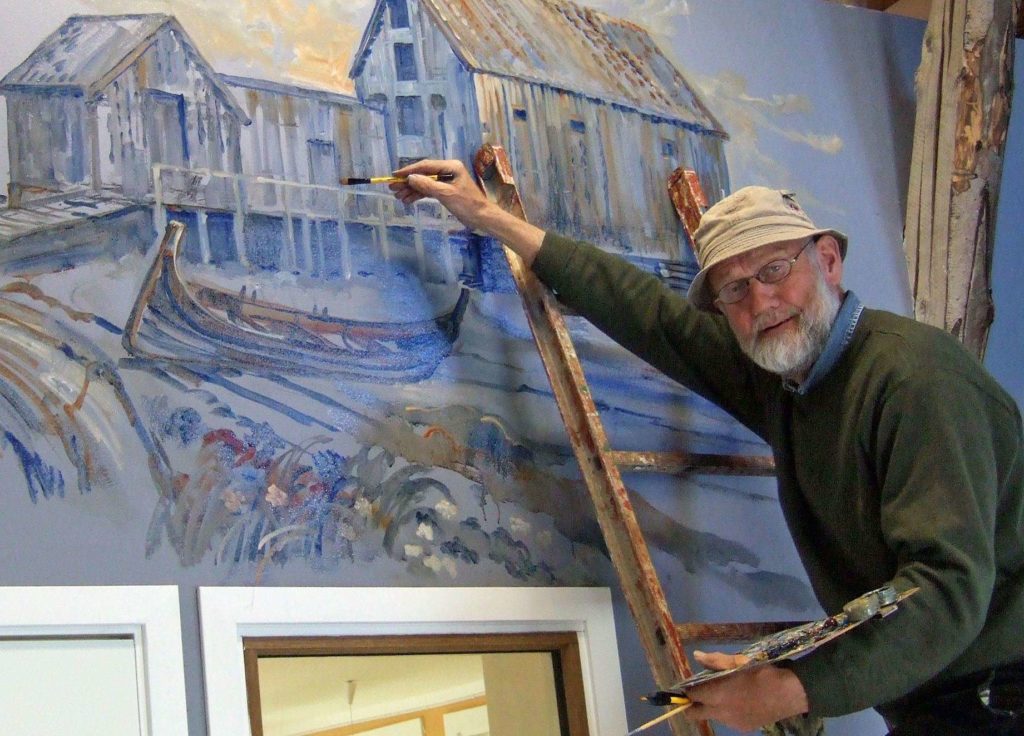
Karl Erik Harr (1940-) is originally from Kvæfjord. As both a painter, graphic artist and author, he is inspired by the landscape of Northern Norway, especially Lofoten. His art reflects both respect and love for nature and traditions, often with a nostalgic look at coastal culture. In his museum on Kjerringøy, there are changing exhibitions to show Harr’s versatile and numerous art in a figurative style. It is therefore easy to recognize him: Here are iconic paintings from Helgeland, Lofoten and the Vestfjord, but also from Kjerringøy, where the artist has lived for parts of the year since 1978.
Kjerringøy – a historical center of coastal culture
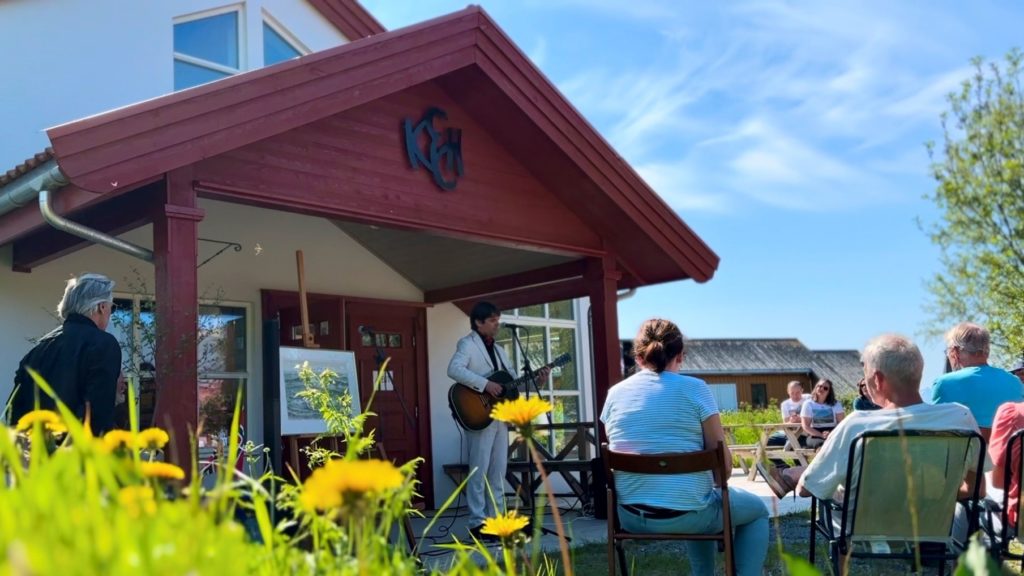
Karl Erik has his own gallery, Harrmuseet on Kjerringøy. His large coastal paintings, which previously hung on board Hurtigruten’s ships, are now on display in the café at Kjerringøy Handelssted.In the trading post’s old operational building, Zahlfjøsen you will find the exhibition “Hamsun in film and pictures”. It provides an insight into films based on Hamsun’s novels, many of which were shot on Kjerringøy. Harr’s illustrations of Hamsun’s many novels are integrated into this exhibition, and a local art shop.
Jan Harr (1945-) from Harstad is the brother of Karl Erik and Eva Harr. Jan is educated at the Norwegian School of Crafts and Art, at Hadeland Glassworks and at the Norwegian Academy of Fine Arts. He made his debut in the Young Artists’ Society in 1967, and is considered one of the young neo-romanticists who formulated a new lyrical experience of nature around 1970. Among other things, he has depicted the era of emigration in northern Norwegian communities and flourishing landscapes. See more of him at the National Museum.
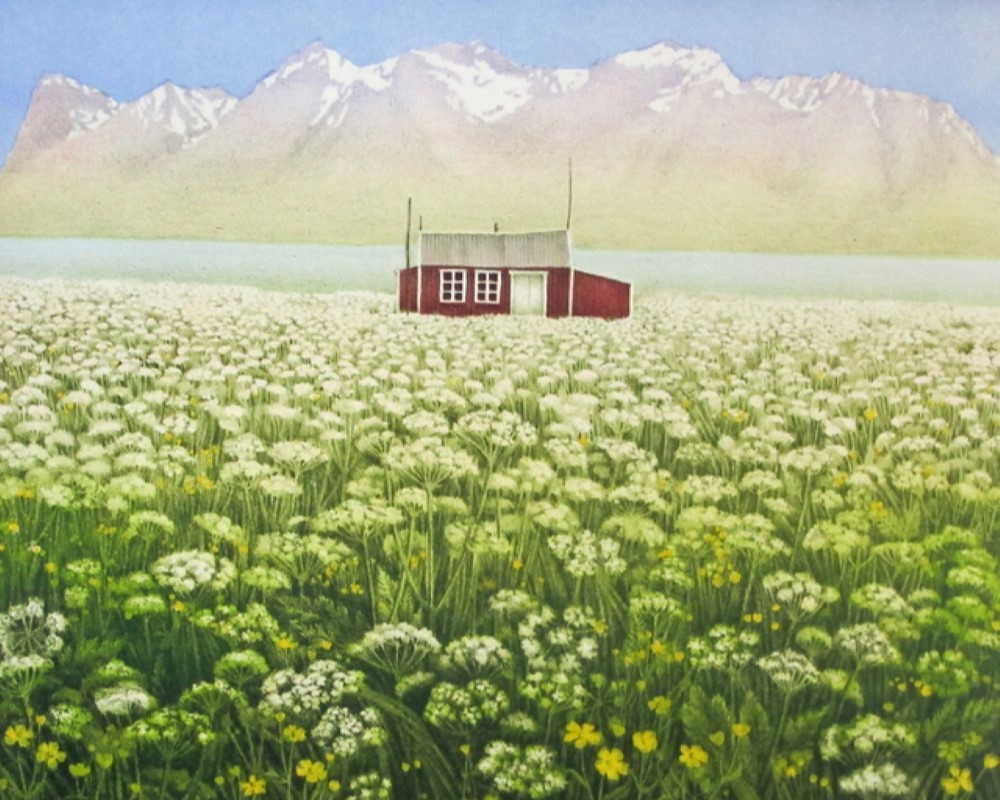
Eva Harr (1951-2024) was a Norwegian visual artist known for her dreamy and poetic landscape motifs. The younger sister of Karl Erik Harr found inspiration in nature, and even though she lived in Oslo for much of her life, there was never any doubt about where she found her motivation. Her northern Norwegian roots ran deep, and her landscape paintings contain both longing and romanticization of the northern region. Reine Cultural Center has a permanent collection of Eva Harr’s paintings.
Reine – a picturesque fishing village in a picturesque landscape
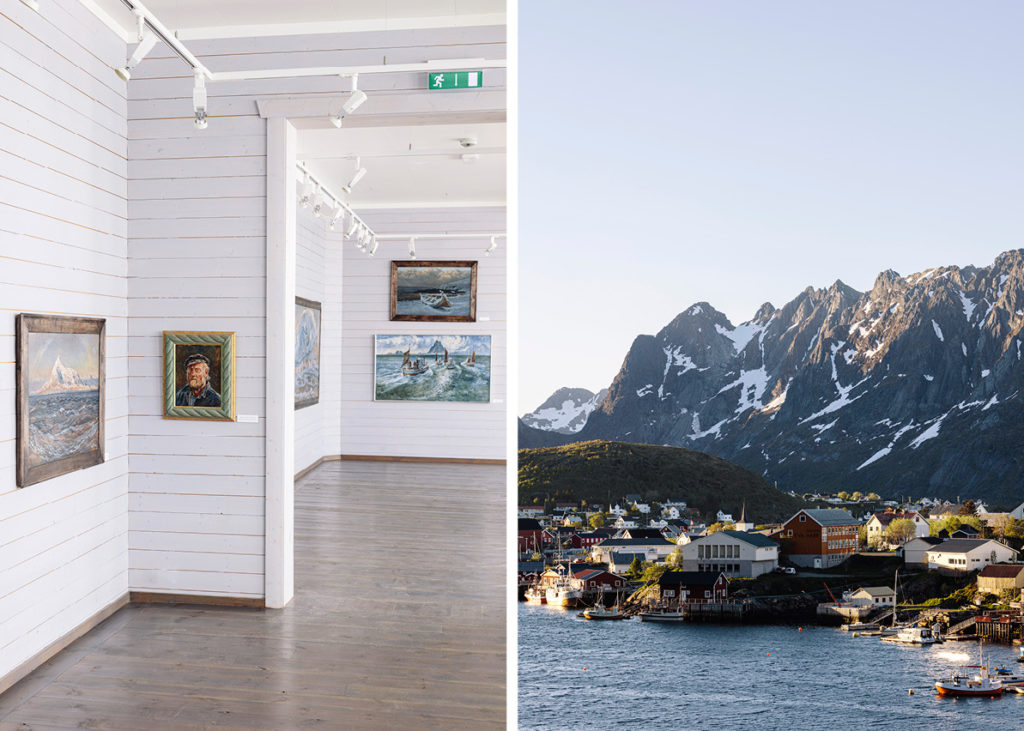
Gallery Eva Harr is located in Reine Cultural Center. The gallery presents a permanent collection of paintings from her artistic career, and a selection of her graphic works. Old houses, mountains and various celestial bodies are among the motifs that recur in the pictures.
Irena Jovic (1973-) was raised on Engavågen in Meløy with a Norwegian mother and a Bosnian-Serbian father. Already as a child she explored drawing and the many possibilities of painting, and her production is mainly thematically threefold: Nordland, Spitsbergen and depictions of people in nature. After 5 years of studies in France, she returned to Norway and was a student at Odd Nerdrum’s studio at the turn of the millennium. In 2005 she received her cand.philol. degree in art history from the University of Oslo. She was also the general manager of the Petter Dass Museum in Alstadhaug for many years. Read more about her at irenajovic.com.
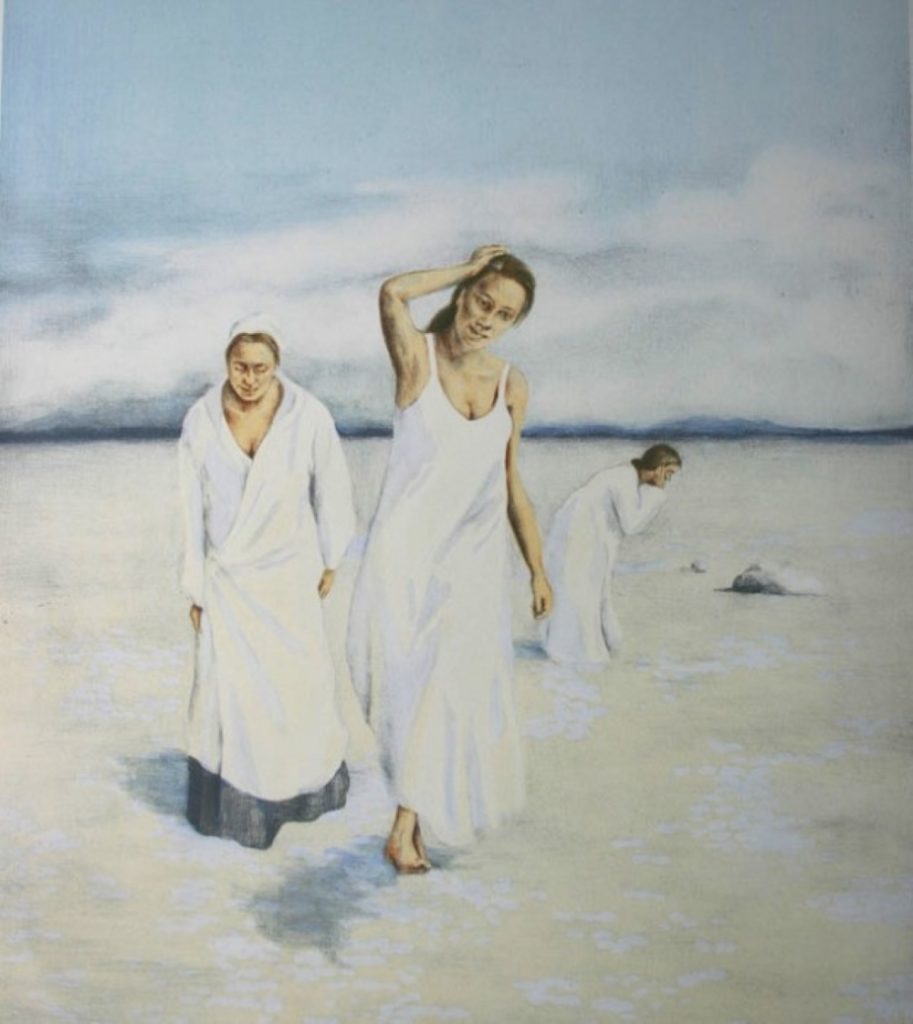
Are Andreassen (1954-) is originally from Tromsø, but lives in Fleinvær outside Bodø where he works with graphics, paintings and installation art. He is particularly interested in local identity and the interaction of nature with culture, which his own contemporary art largely reflects – whether it is a print or an installation out on a windswept islet:
NordlandiART – a region seen through the eyes of artists
Are Andreassen was one of the initiators behind the art dissemination project NorlandiART from 2016, which shows stories from and about the region seen through the eyes of artists in various locations in the city of Bodø.
Hugo Aasjord (1955) from Steigen has a gallery on Engeløya. He studied art in Germany and has a versatile career with a lot of abstract art, which is often inspired by the coast and sea in Northern Norway. He is also working on restoring an old fishing farm in Skrova to become a gallery. As an artist, he has been responsible for several public decoration assignments. Hugo Aasjord is also the main character in author Morten Strøksnes’ bestseller “Havboka”. Read more about him at hugoaasjord.com.
Lars Erik Karlsen (1948-) was born in Trysil, graduated from the State School of Crafts and Art in Oslo, but lives and works in Svolvær in Lofoten, where he has a studio. Here he uses coastal landscapes and seabirds in his art, and he is particularly known for his puffin motifs. He creates woodcuts that appear figurative from a distance, while they have more colorful and abstract nuances up close. Read more about him at larserikkarlsen.no.
Yngve Henriksen (1965-) from Svolvær is based in his home region of Lofoten. He is a graduate of the Art School in Kabelvåg and the Norwegian National Academy of Arts and Design in Bergen. From his studio in the capital of Lofoten, he paints on the border between the figurative and the abstract, always driven by the landscape he lives and breathes in. Henriksen seeks the special energy of the north, which exists in both physical and mental form. Read more about him at the Artists’ Association.
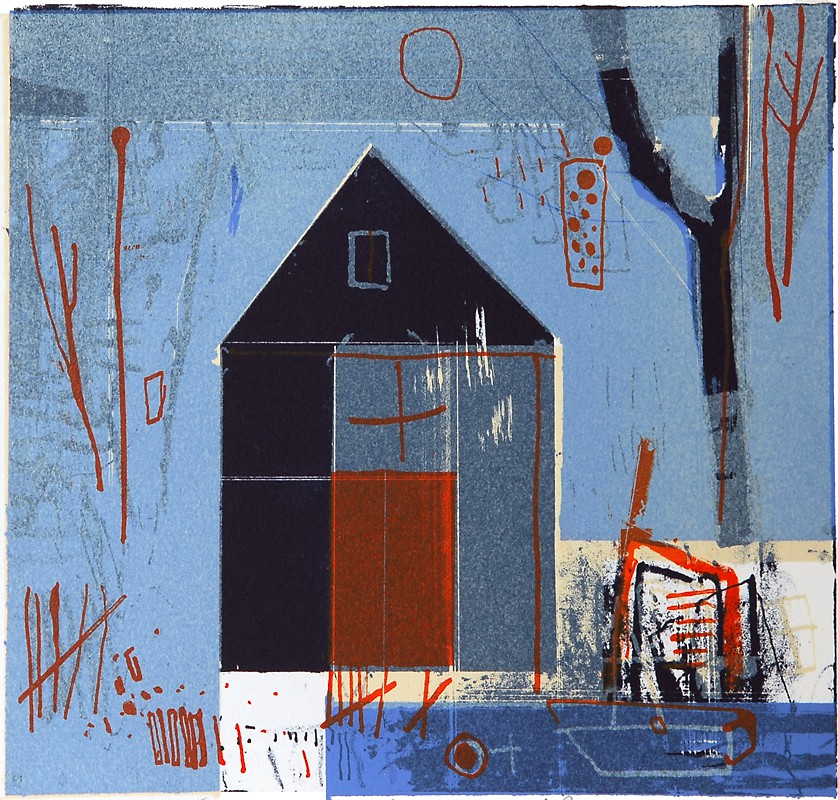
Gunn Vottestad (1949-) from Myre in Vesterålen is a painter and graphic artist. She studied drawing and painting for five years with Hans Köhler and at the Oslo School of Drawing and Painting, and after her artistic debut in 1997 she has become known for her characteristic motifs of northern Norwegian houses, churches and fishing villages. The artist lives in Oslo, but regularly travels to her house in Nyksund – and has stated that the eternal longing and attraction of northern Norway is one of the reasons for her painting style. Read more about him at gunnvottestad.com.
Alvin Jensvold (1954-) is from Målselv and lives in Gratangen in Troms. Painter and graphic artist who, through a combination of traditional and newer techniques, creates colorful, expressive and vibrant images with a strong presence. The motifs range widely and deal with both nature and people, society and culture, as well as literary motifs. See more of him at Gallery Jensvold.
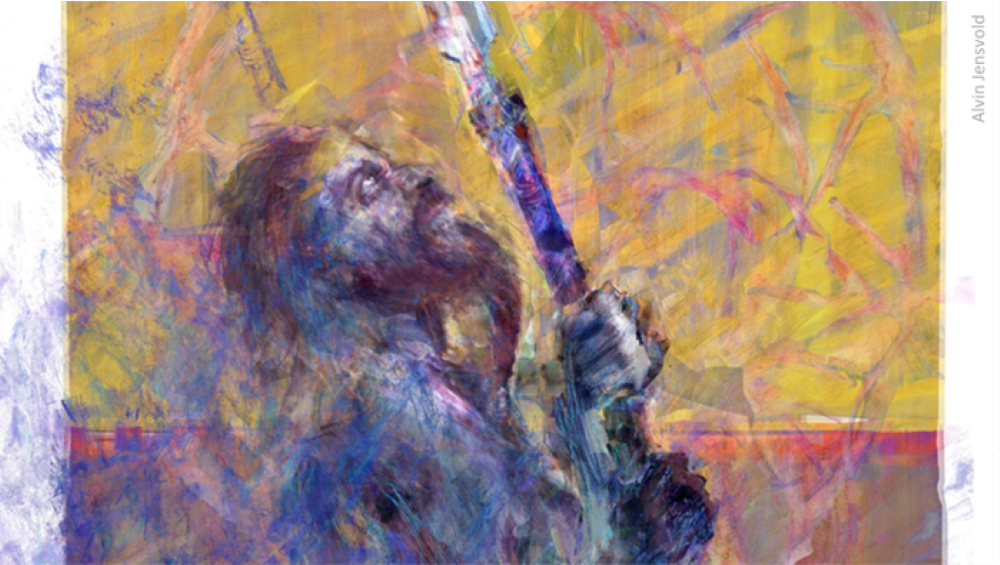
Marit Kristine Bockelie (1933-) is a visual artist and musician from Bodø, but raised in Tromsø and living in Oslo. She has worked with drawings, watercolors, graphics, oil painting and especially mosaics. Bockelie has, among other things, an art education from the “Mosaikk-akademiet” Accademia di Belle Arti in Ravenna, Italy. The facade of several buildings in Tromsø is decorated with Bockelie’s mosaics, including the beautiful “Solkysset” at Torgcenteret in the heart of the city. Read more about her at maritbockelie.no.
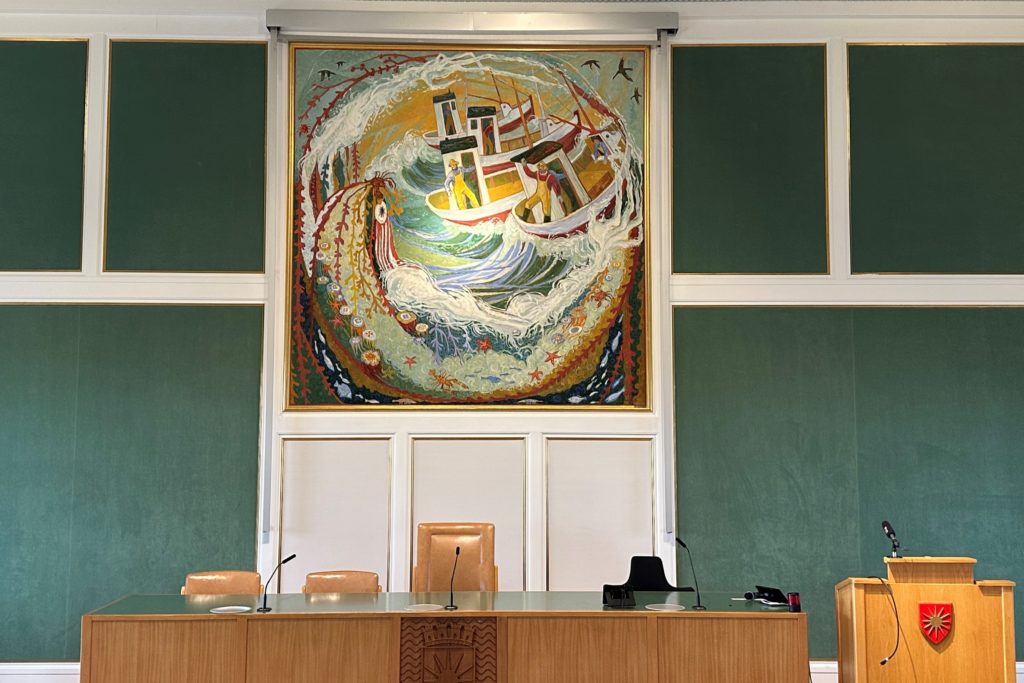
From classical painters to modern visual artists
We have chosen to highlight more classical painters, who have been inspired by our picturesque region throughout the ages.
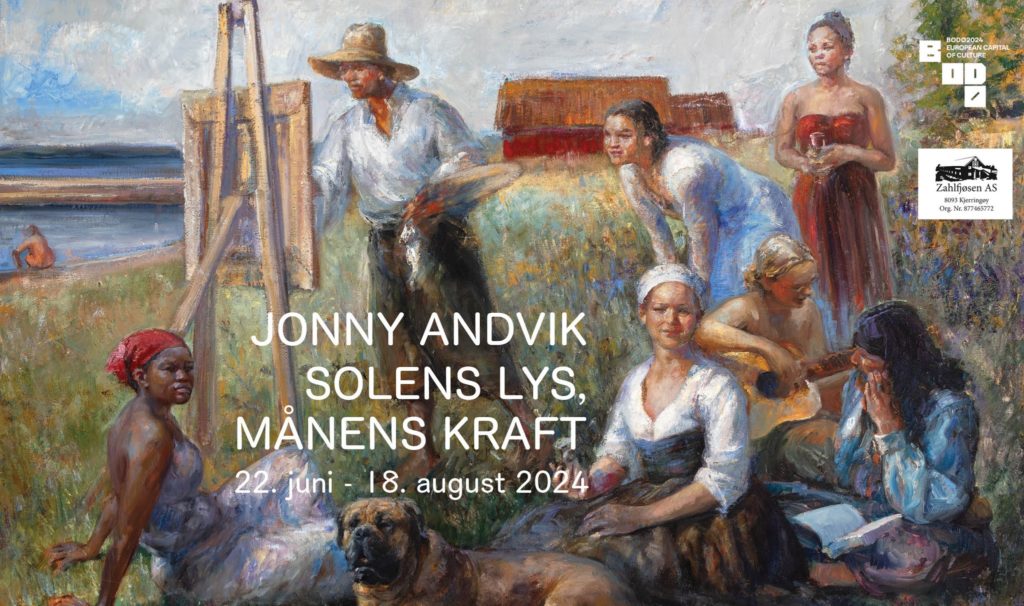
You can read more about the region’s active and more modern visual artists at Northern Norwegian Artists’ Center.
Hope that you too can find inspiration and experiences in the northern landscape, whether it’s with a paintbrush, camera or mobile phone!
Sources: Wikipedia, Norwegian Artists’ Encyclopedia, National Museum, the artists’ websites and art books
